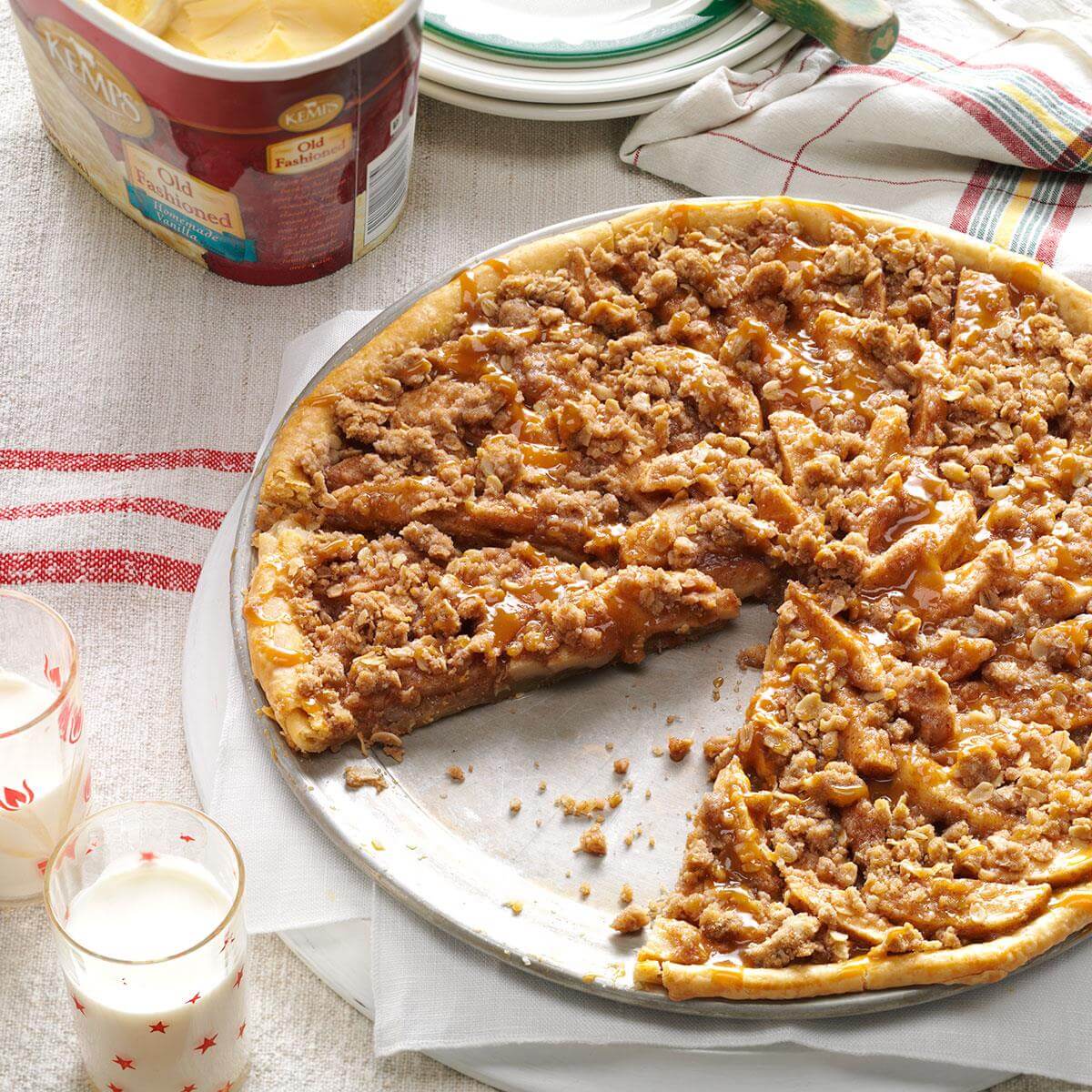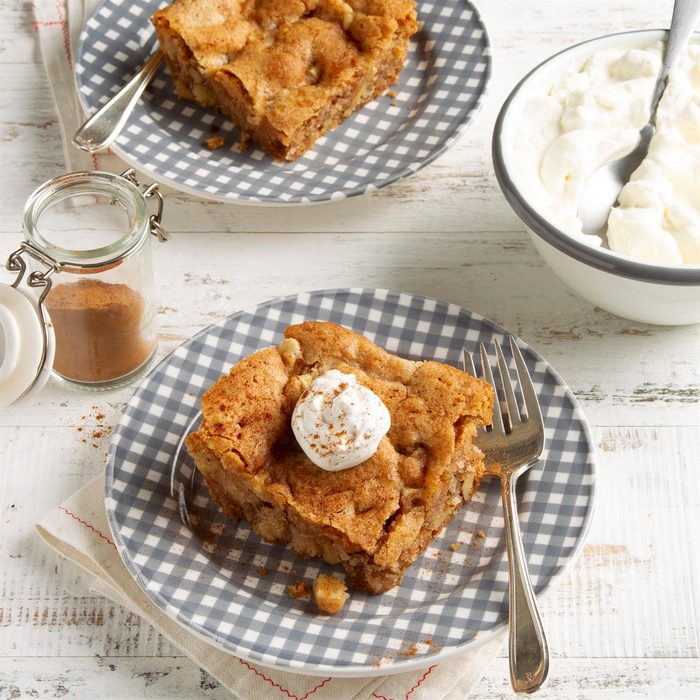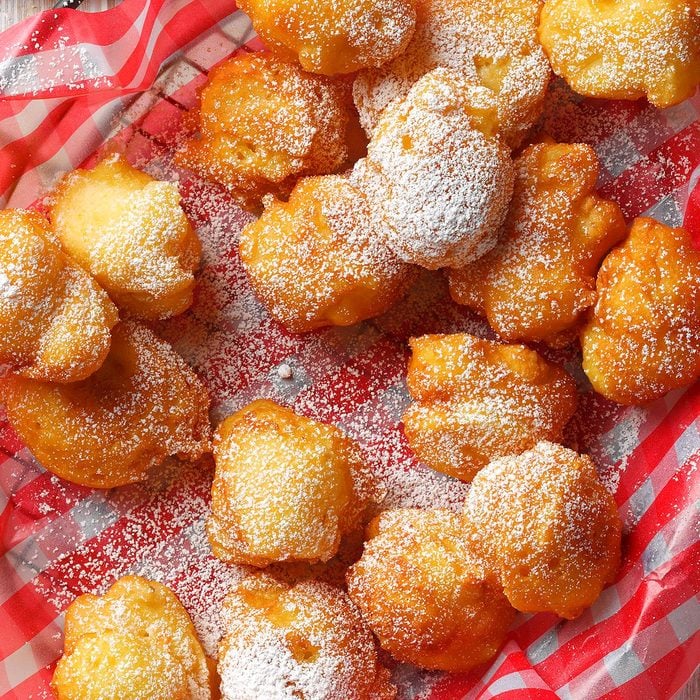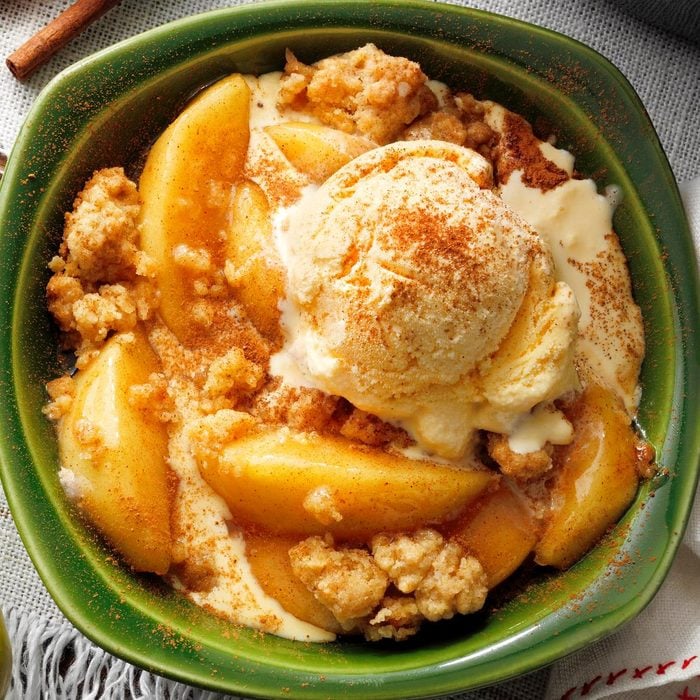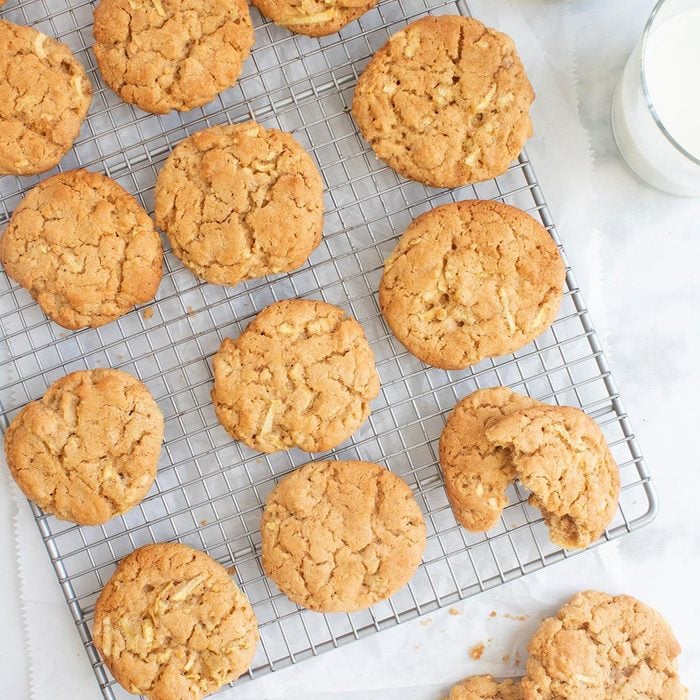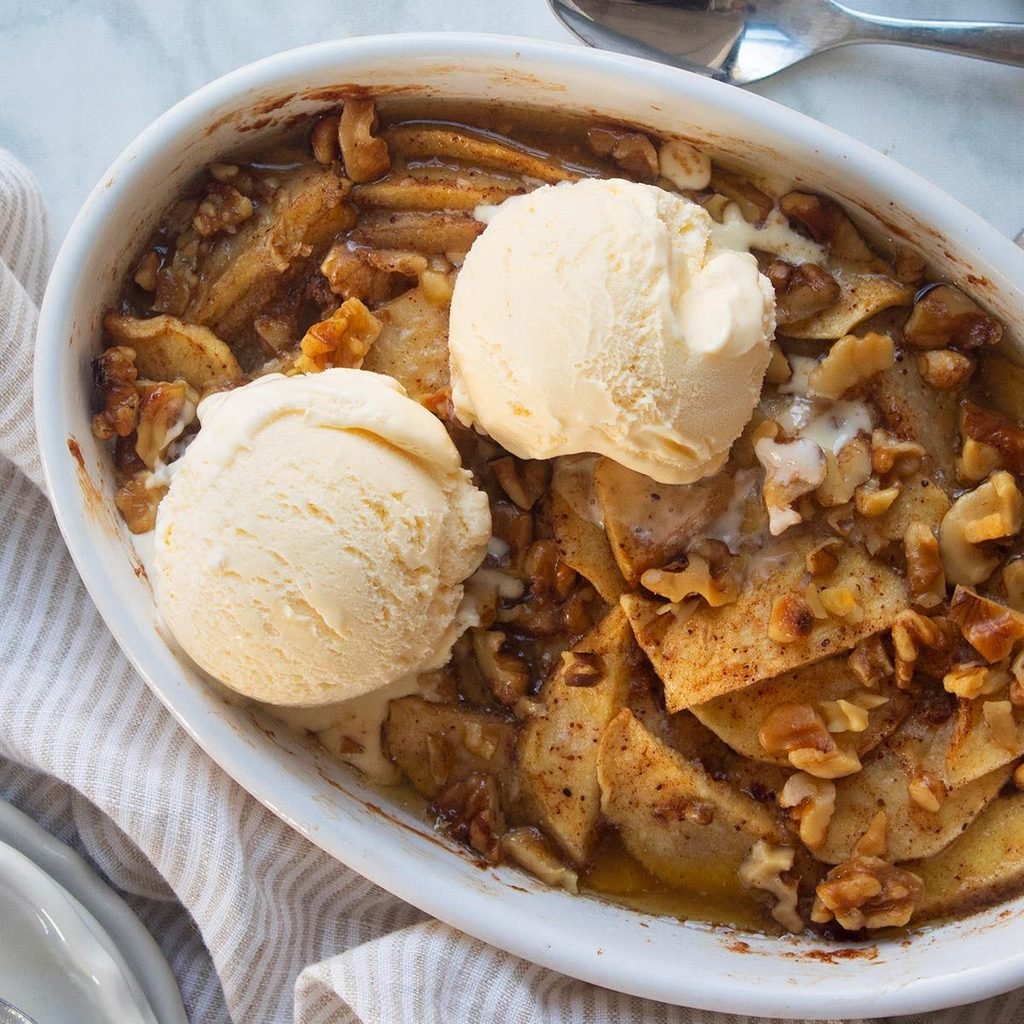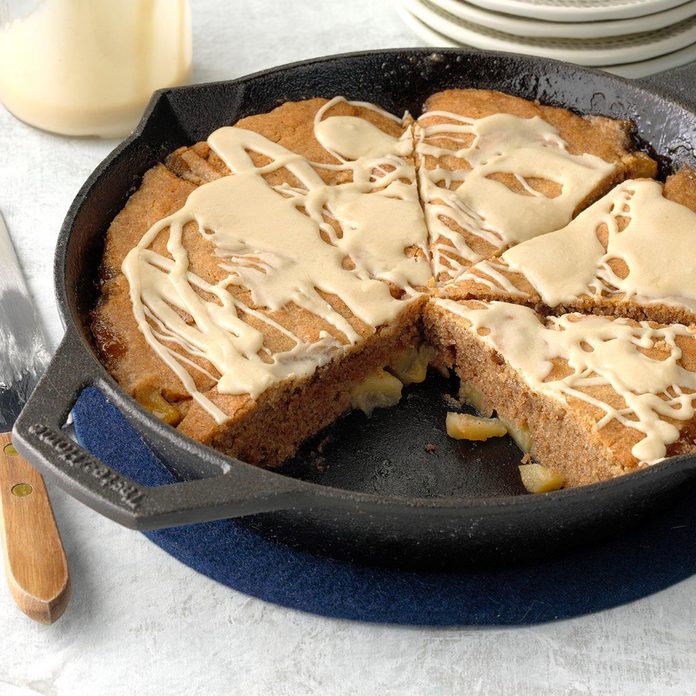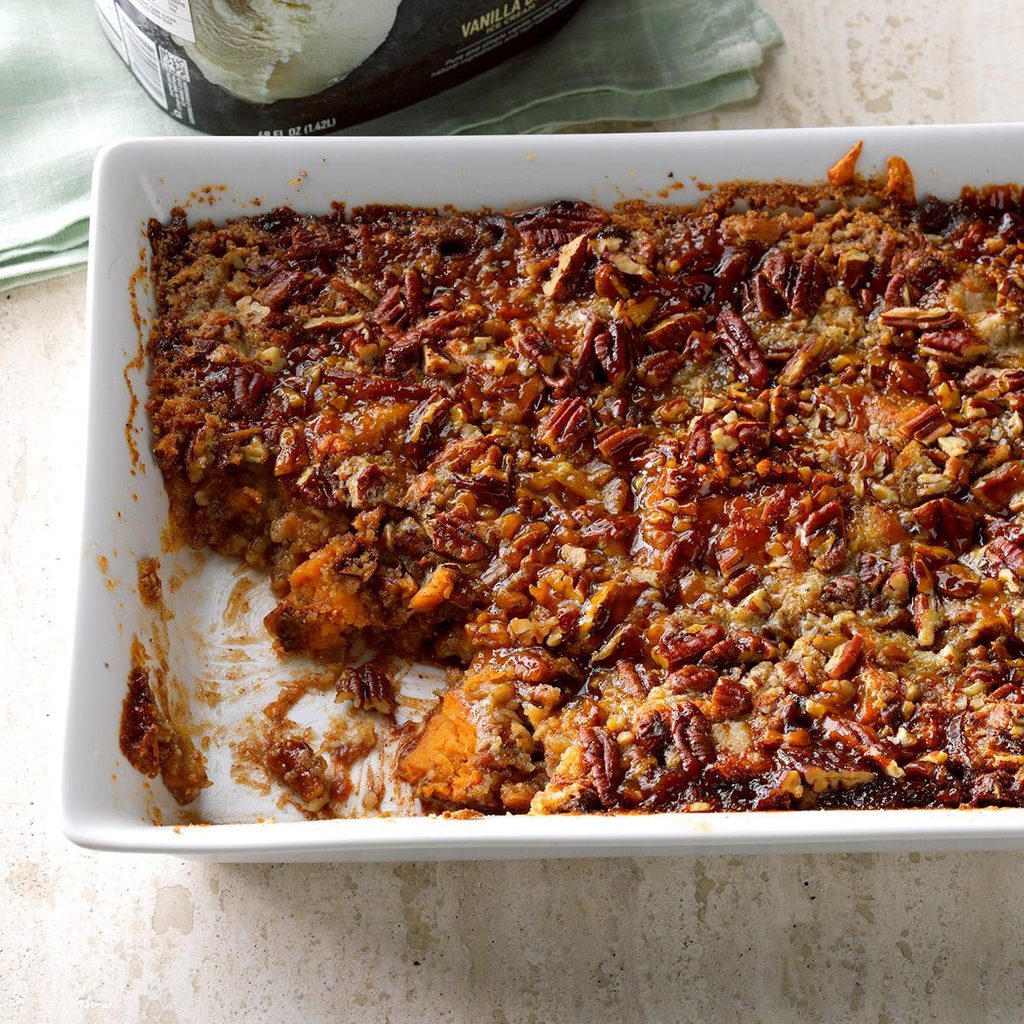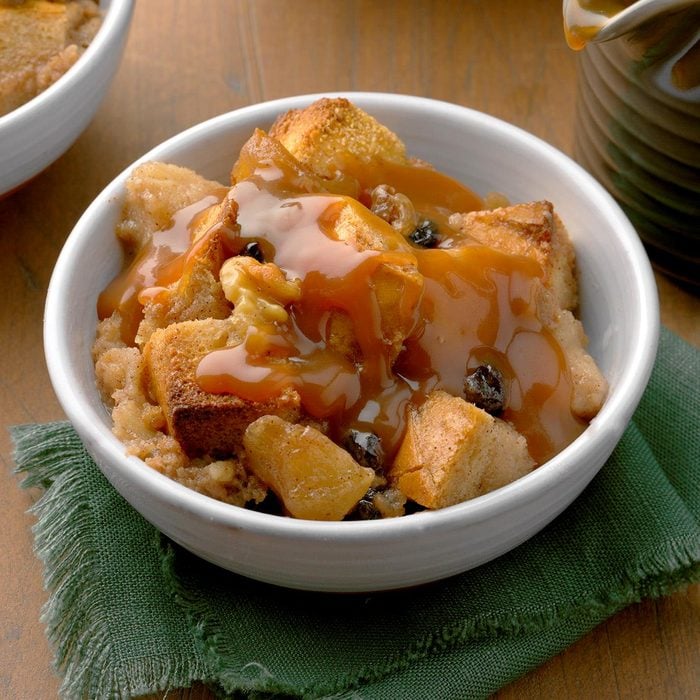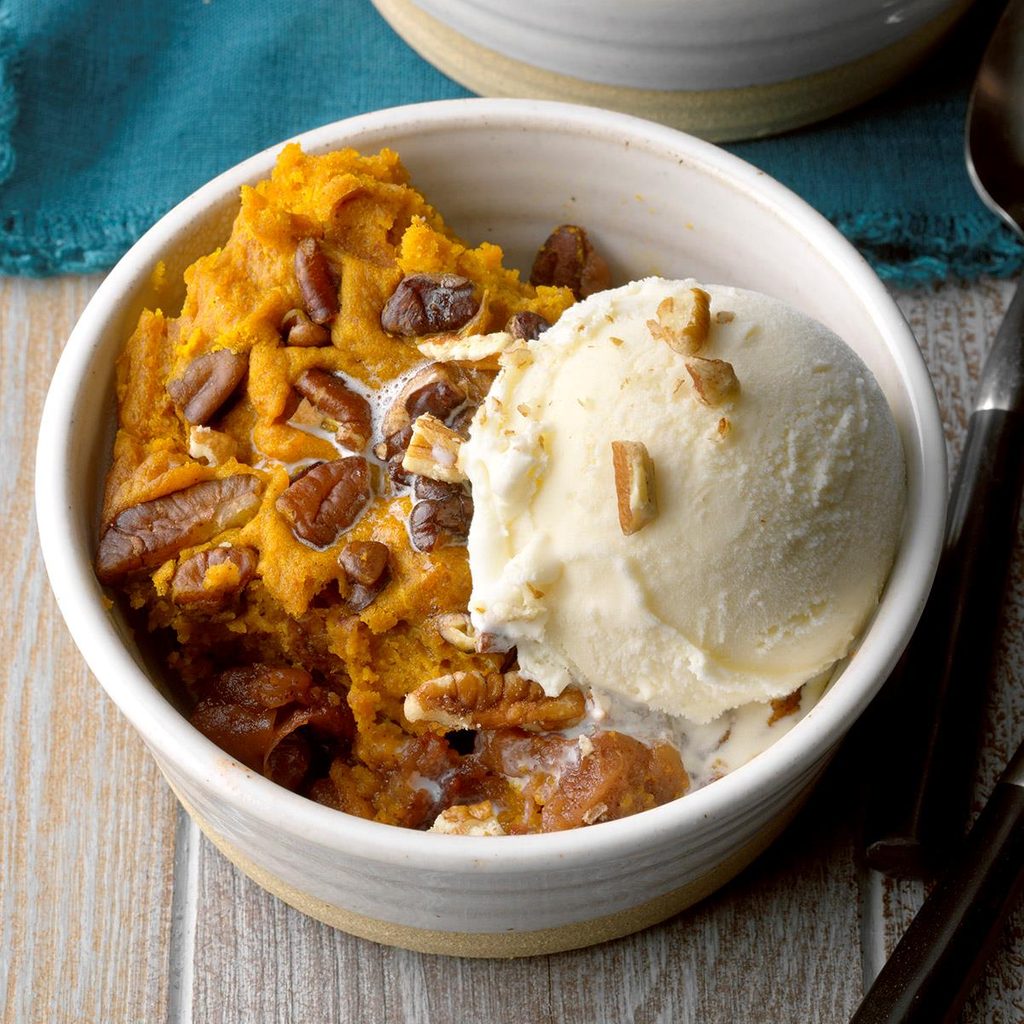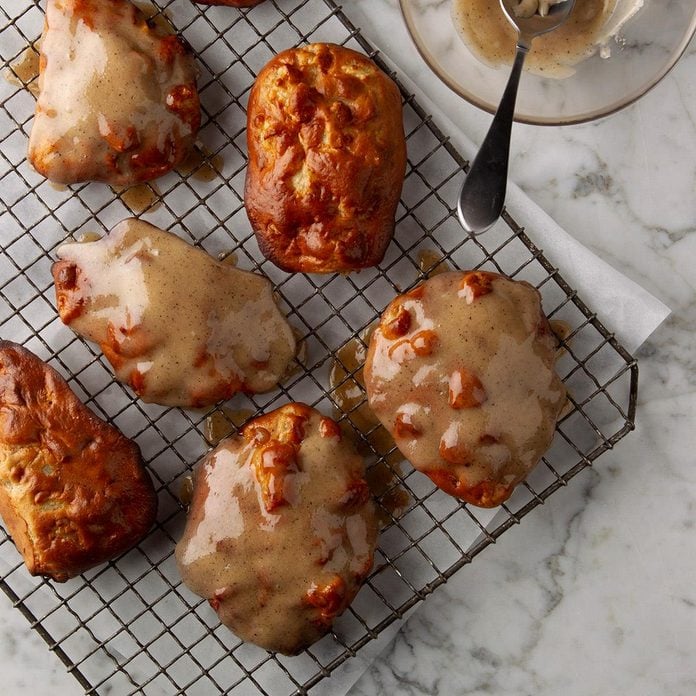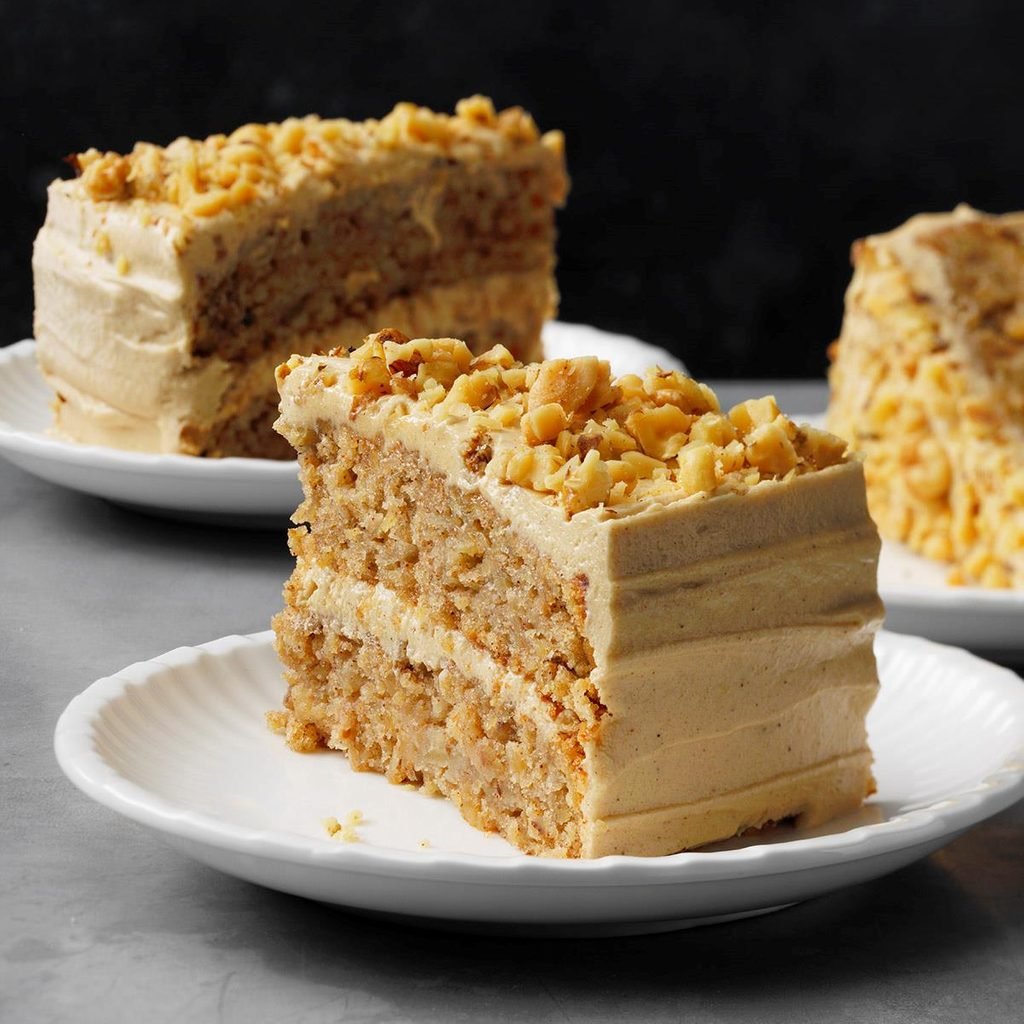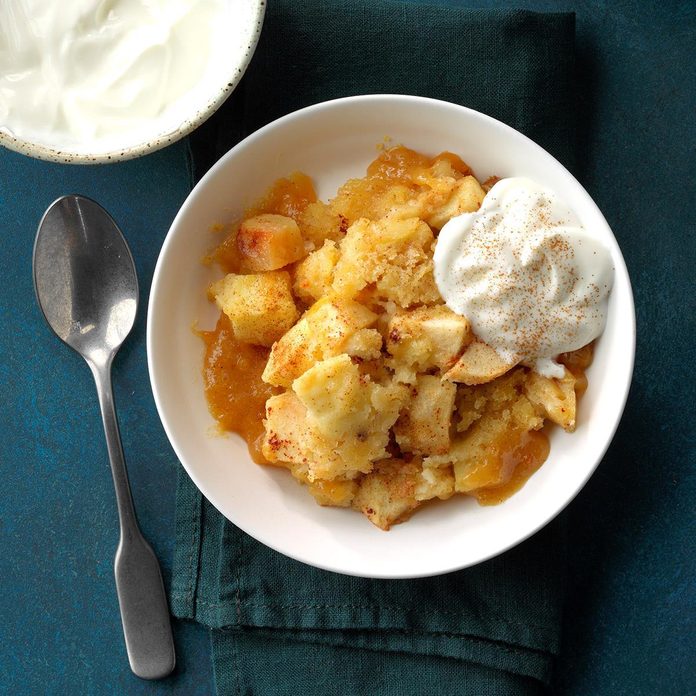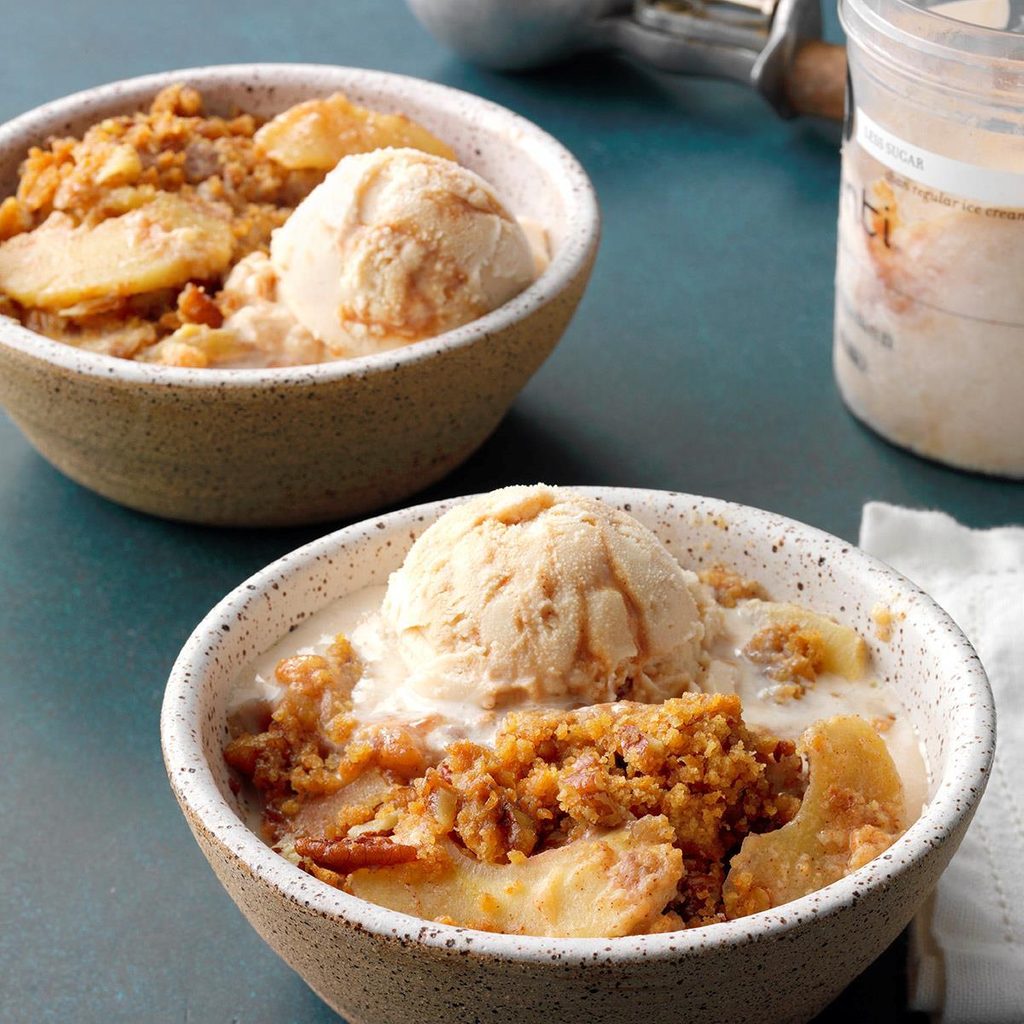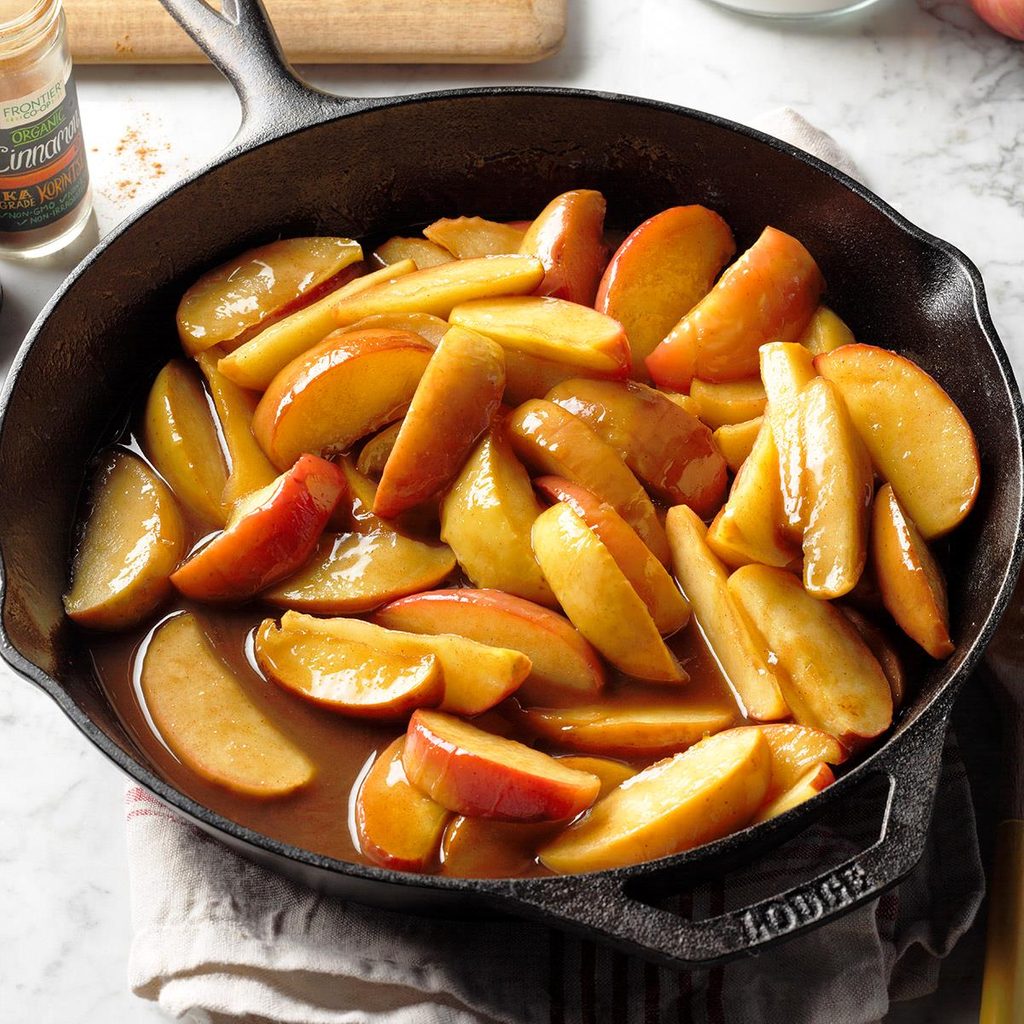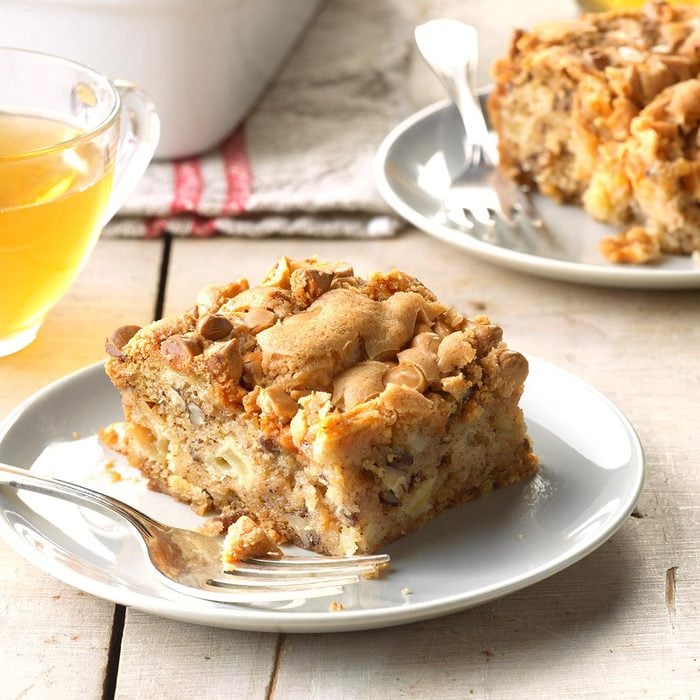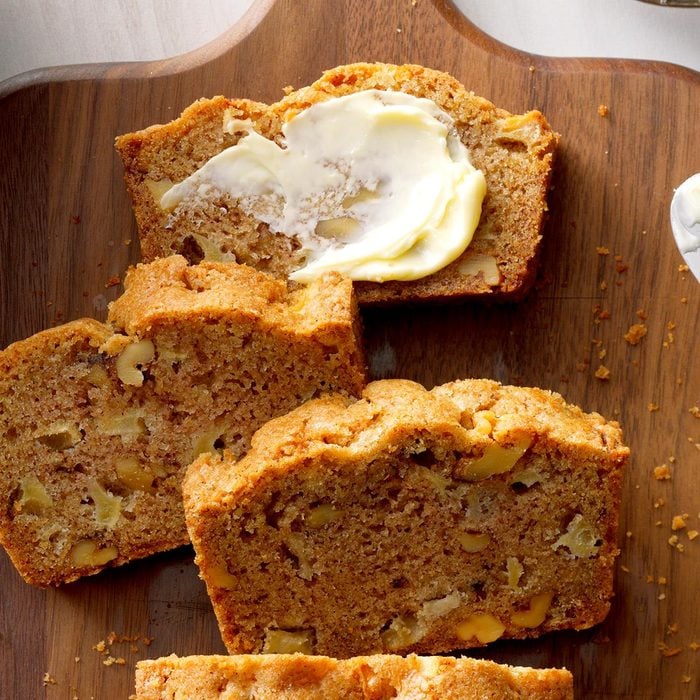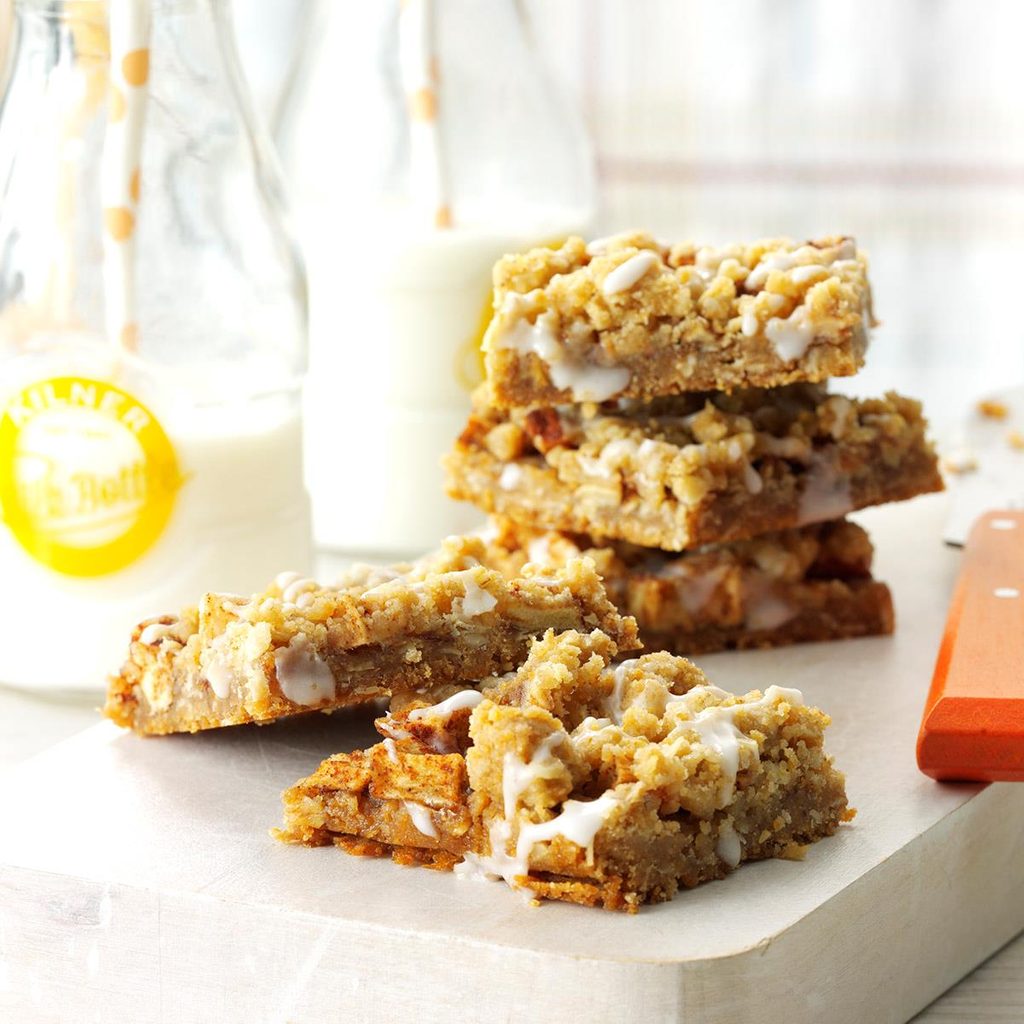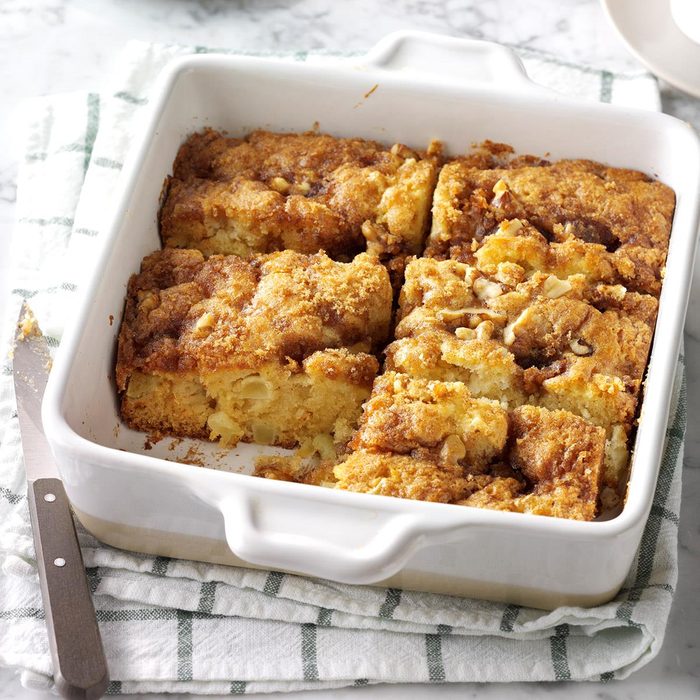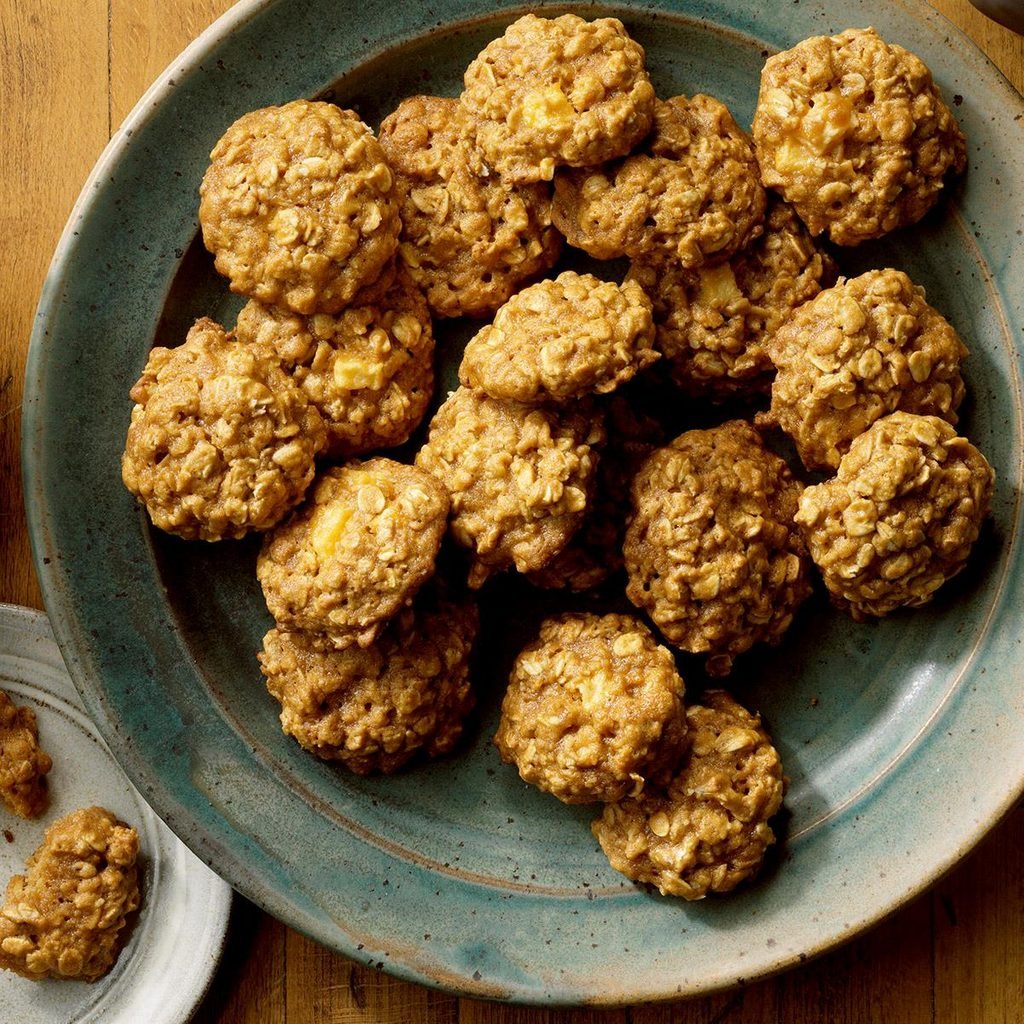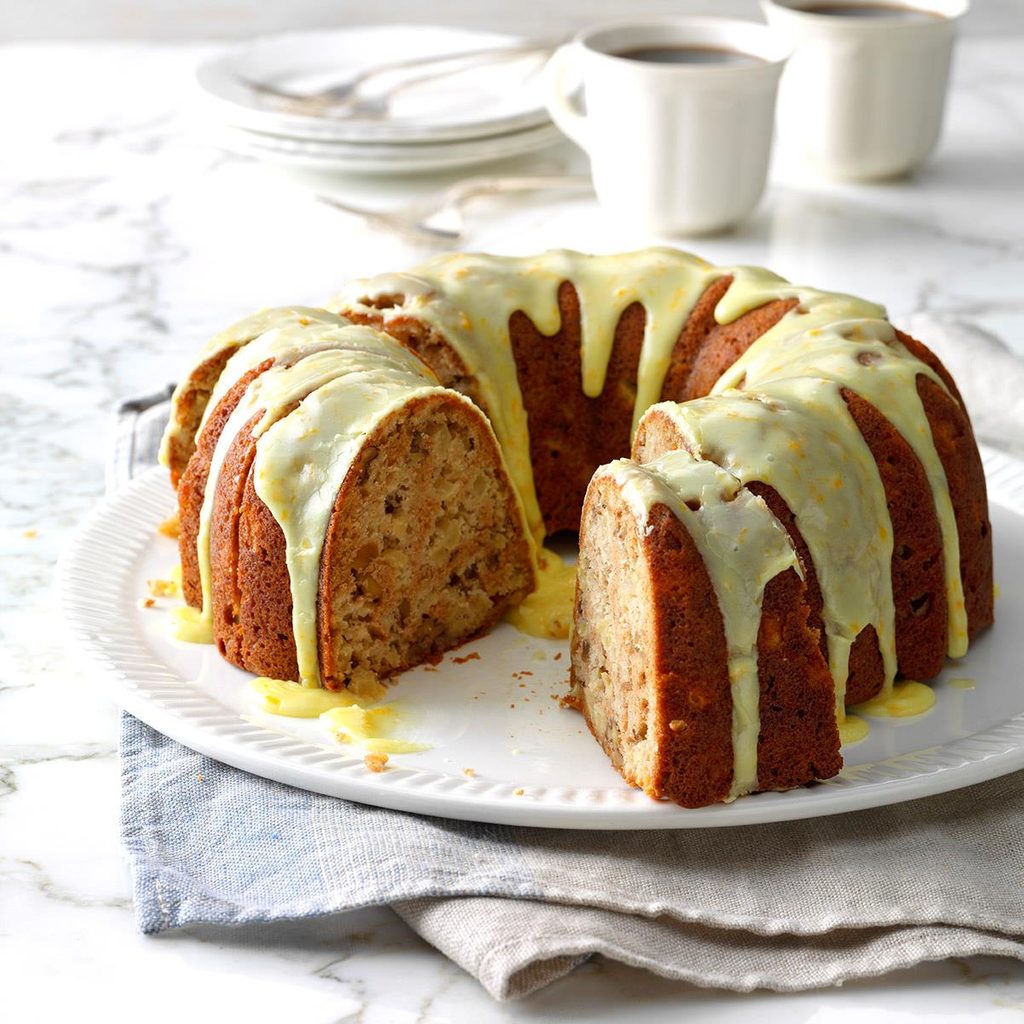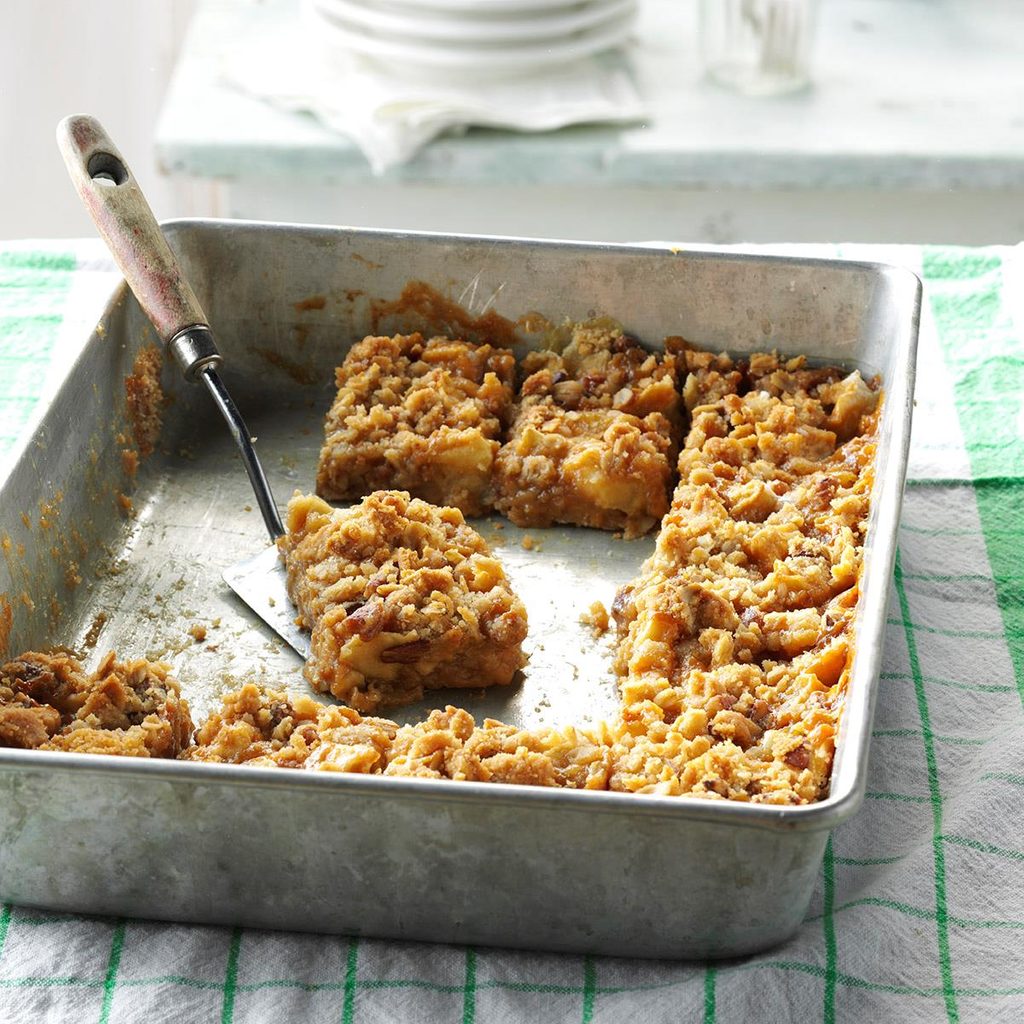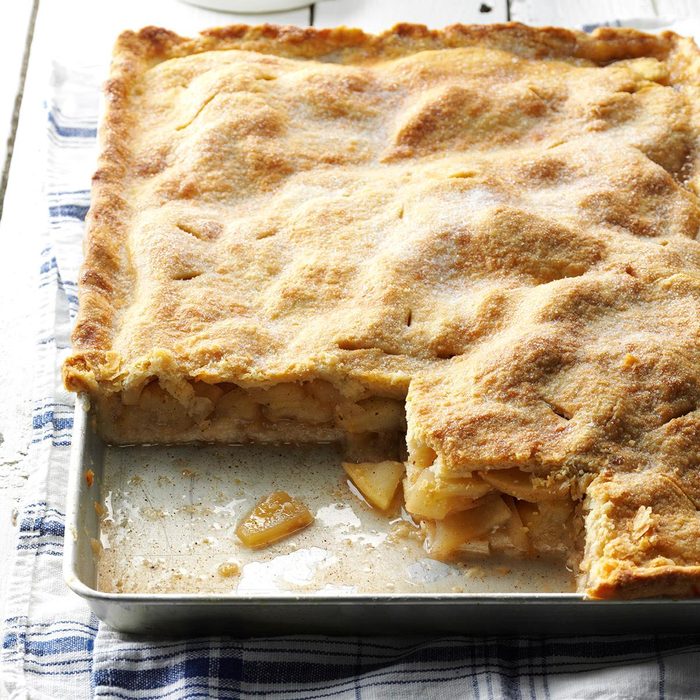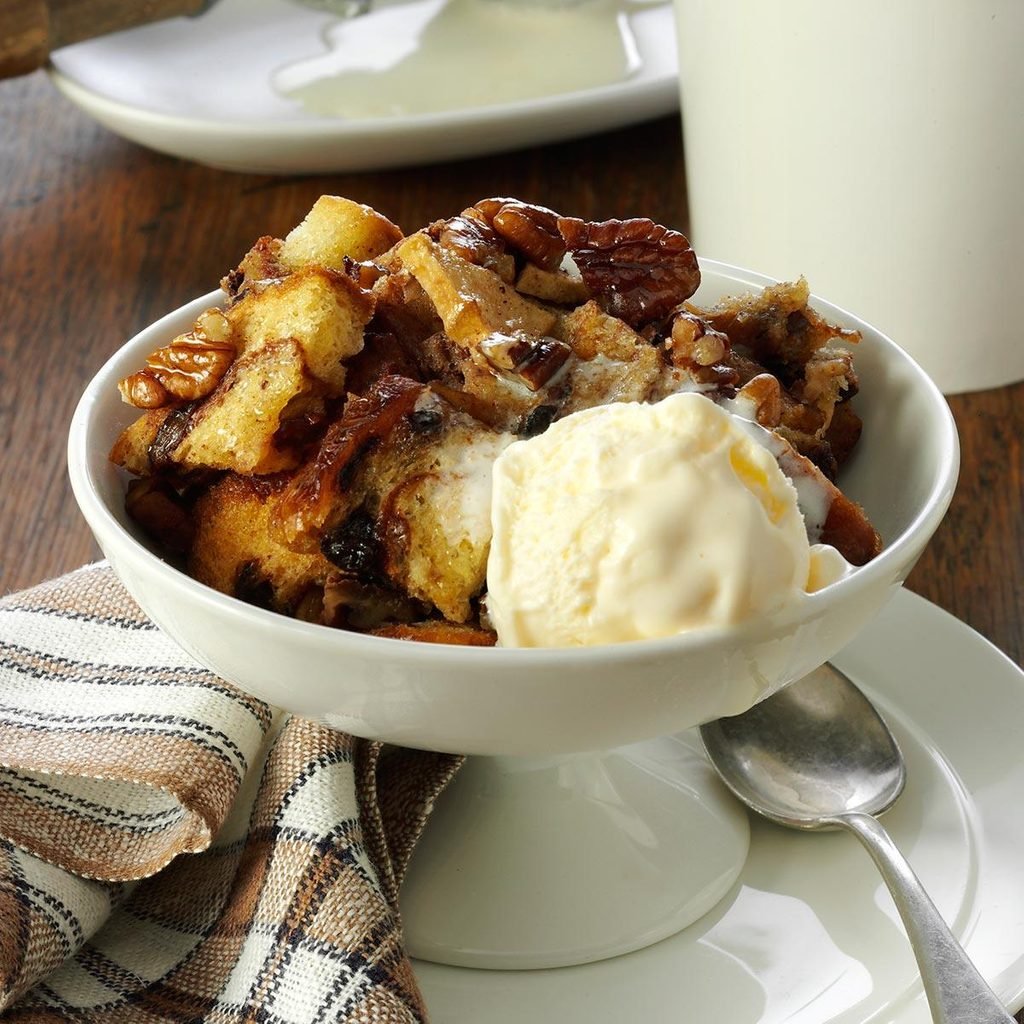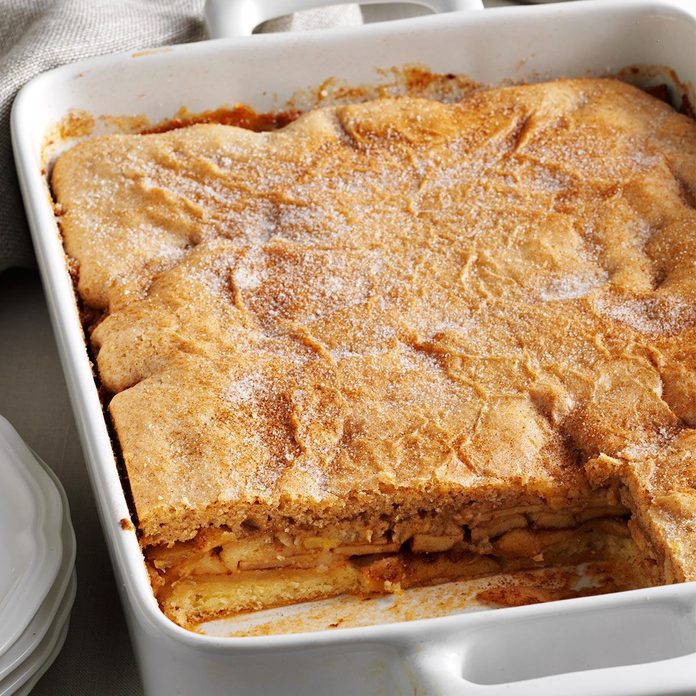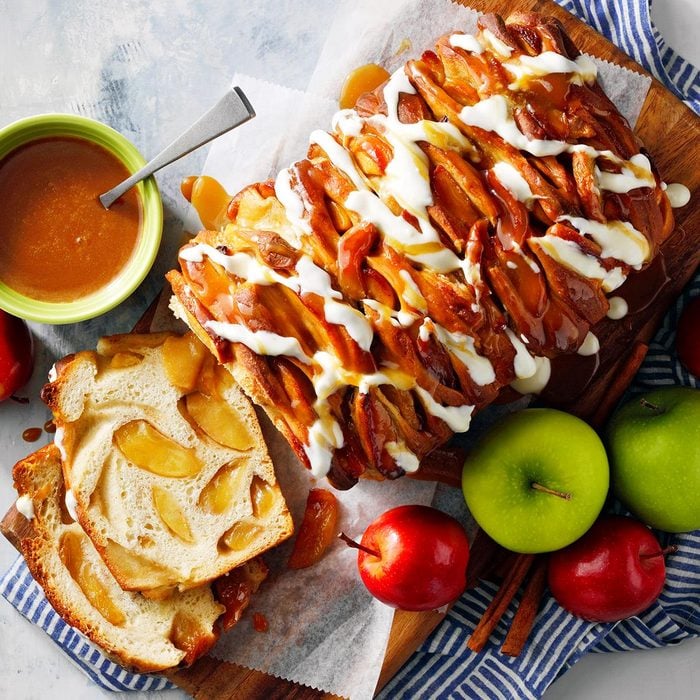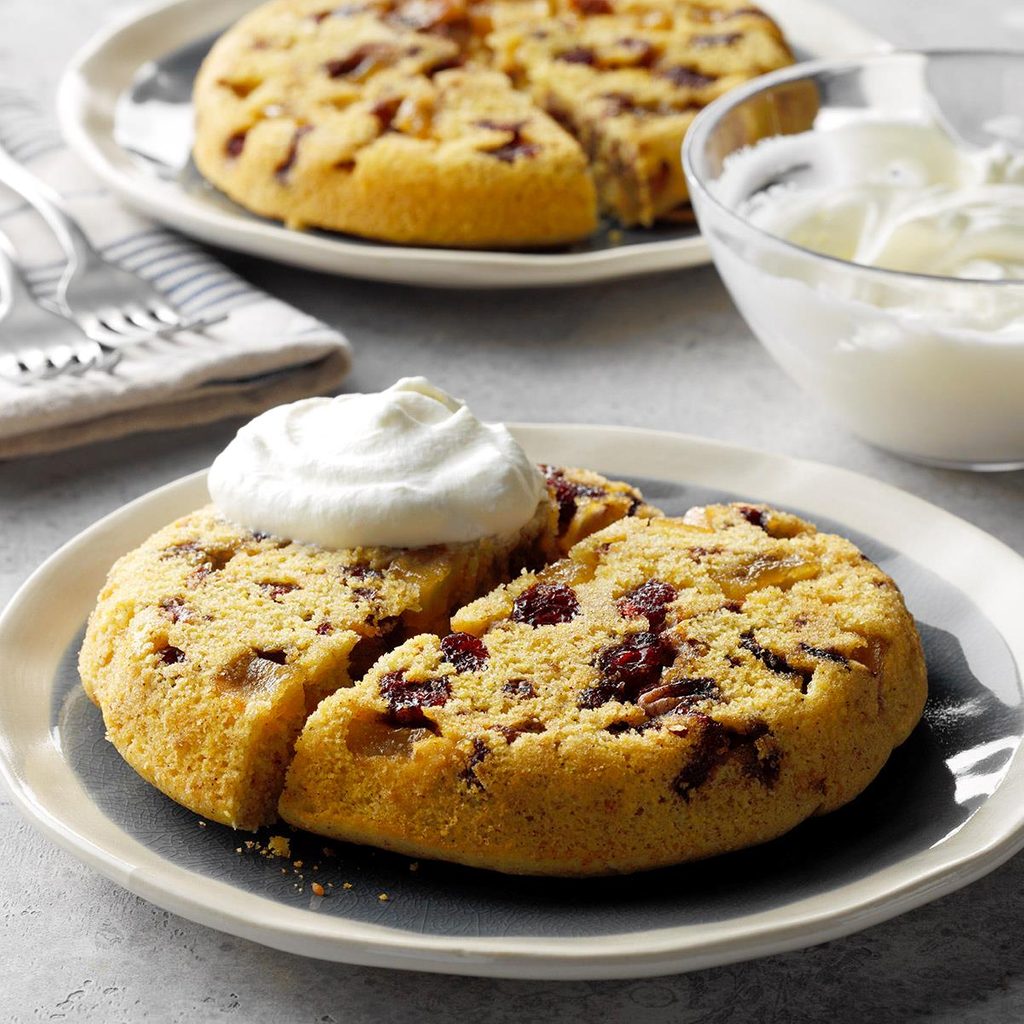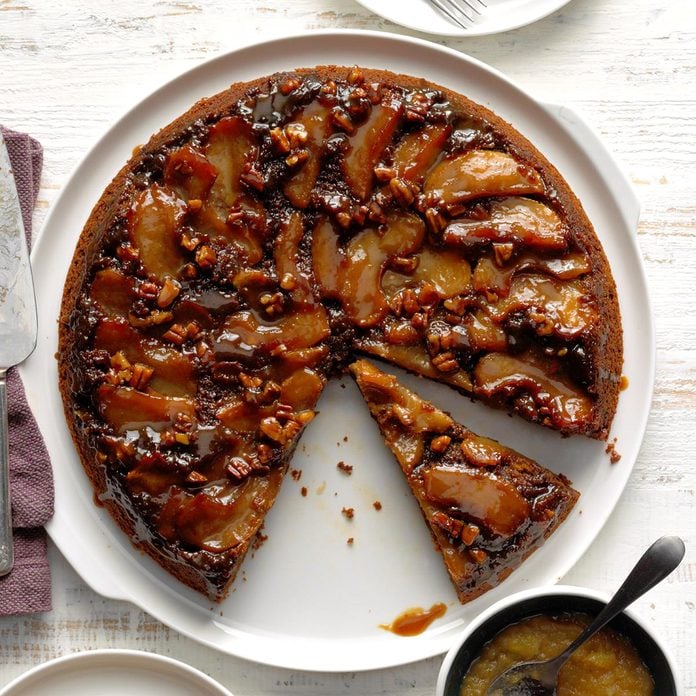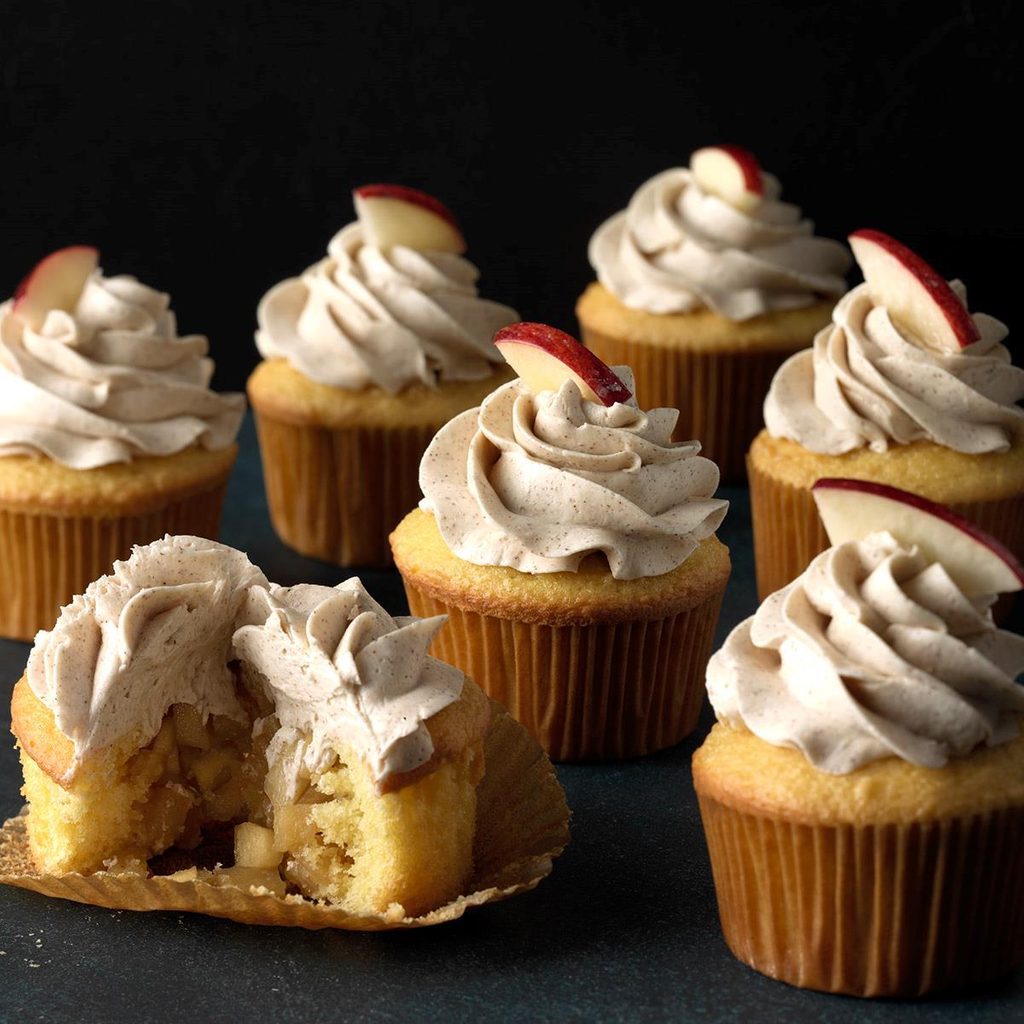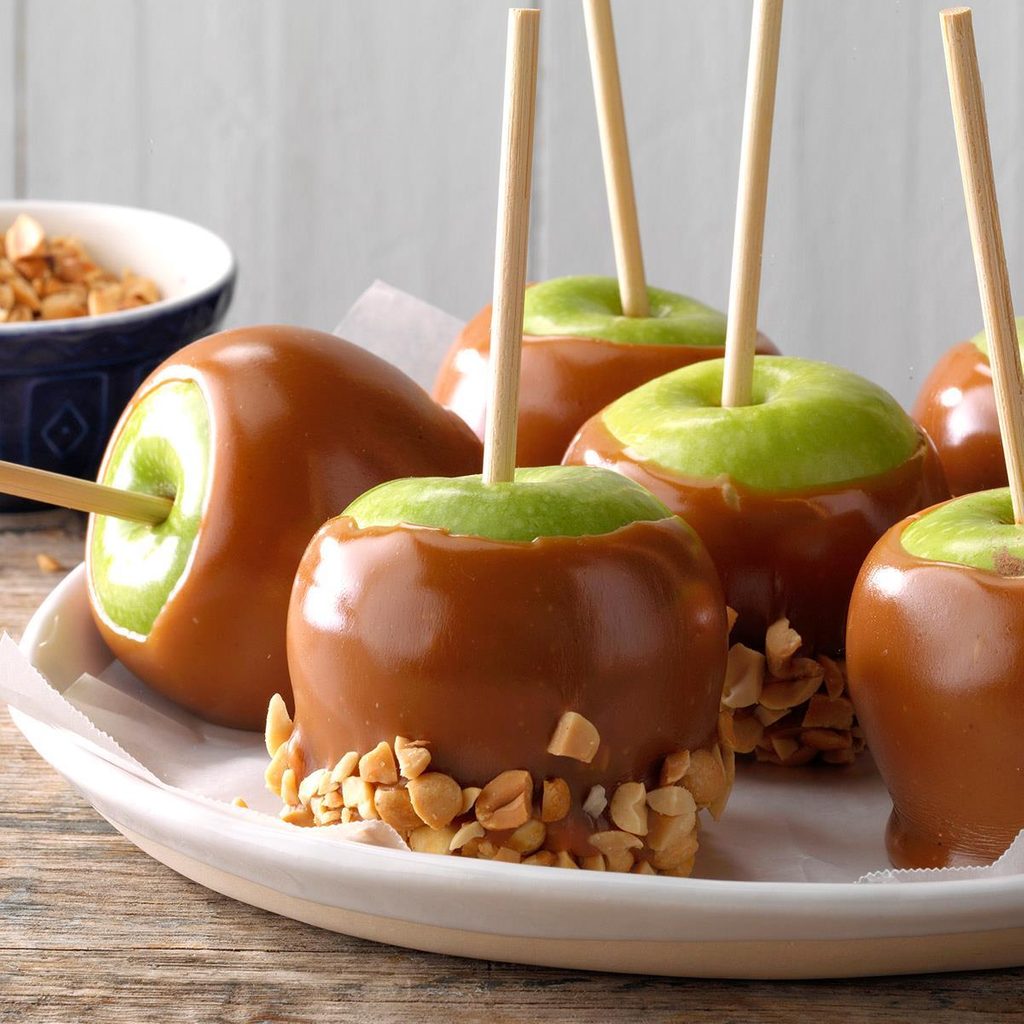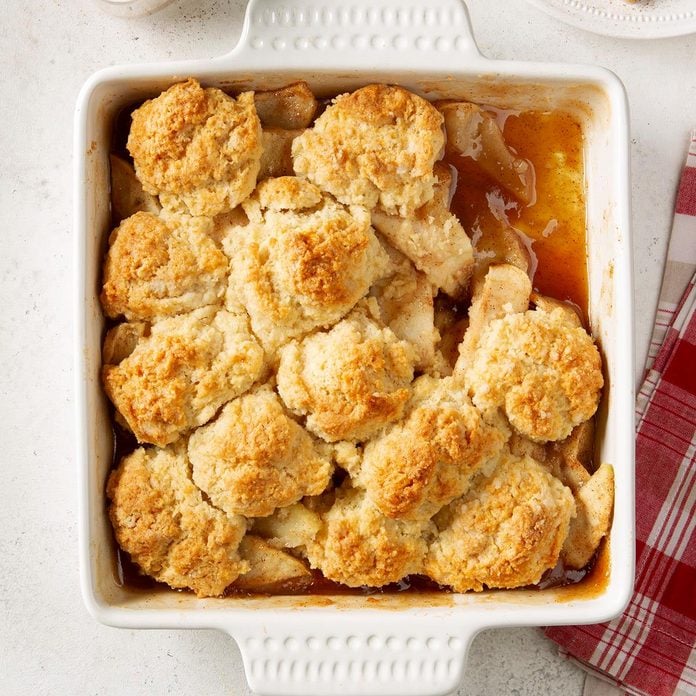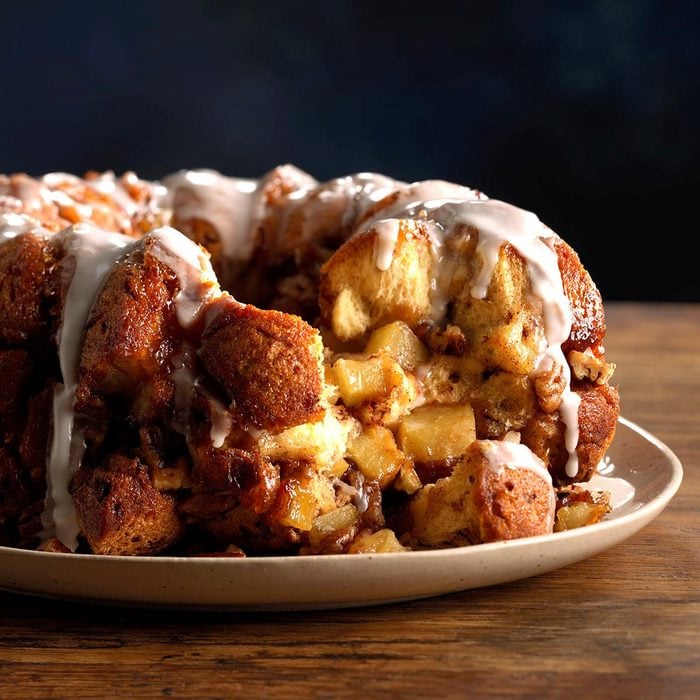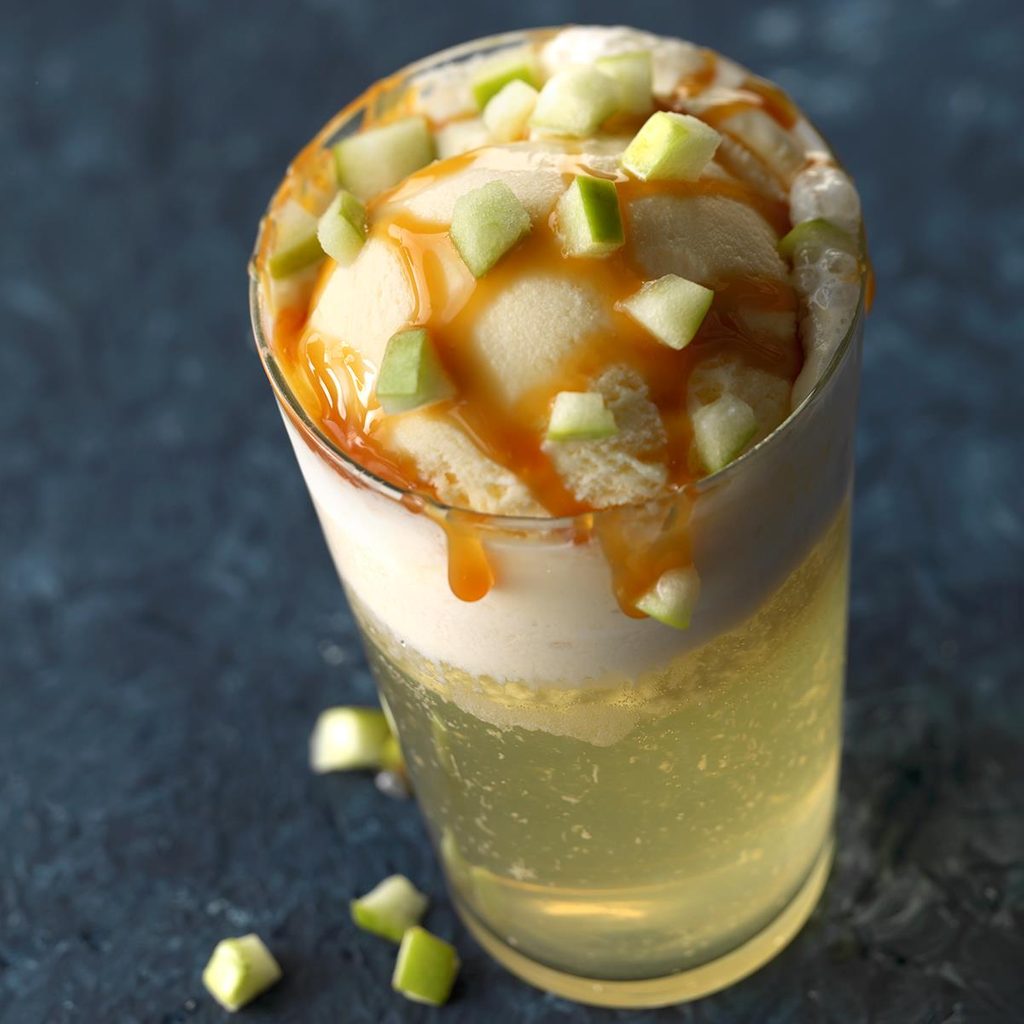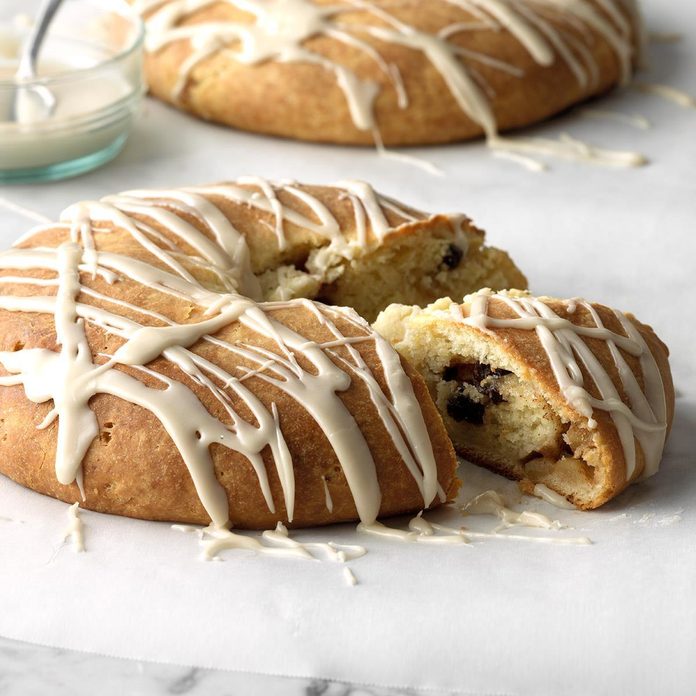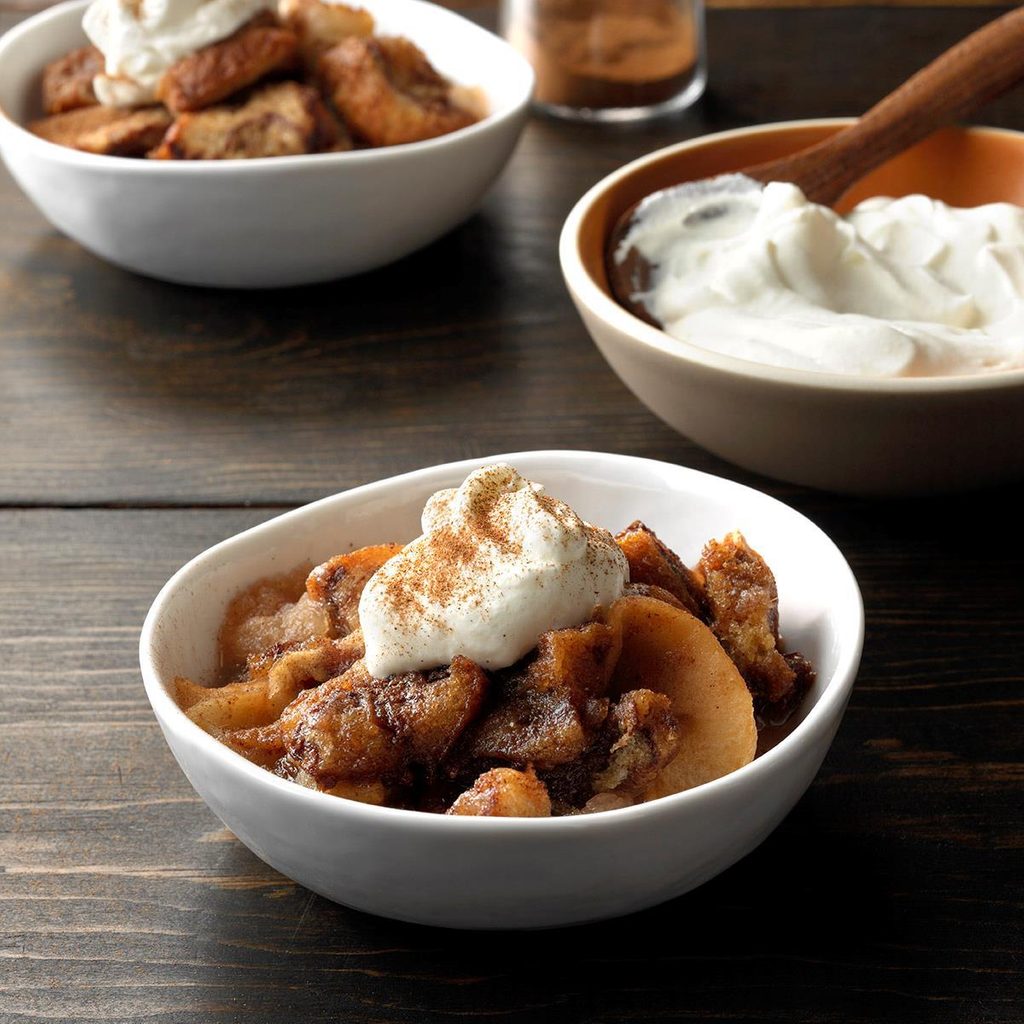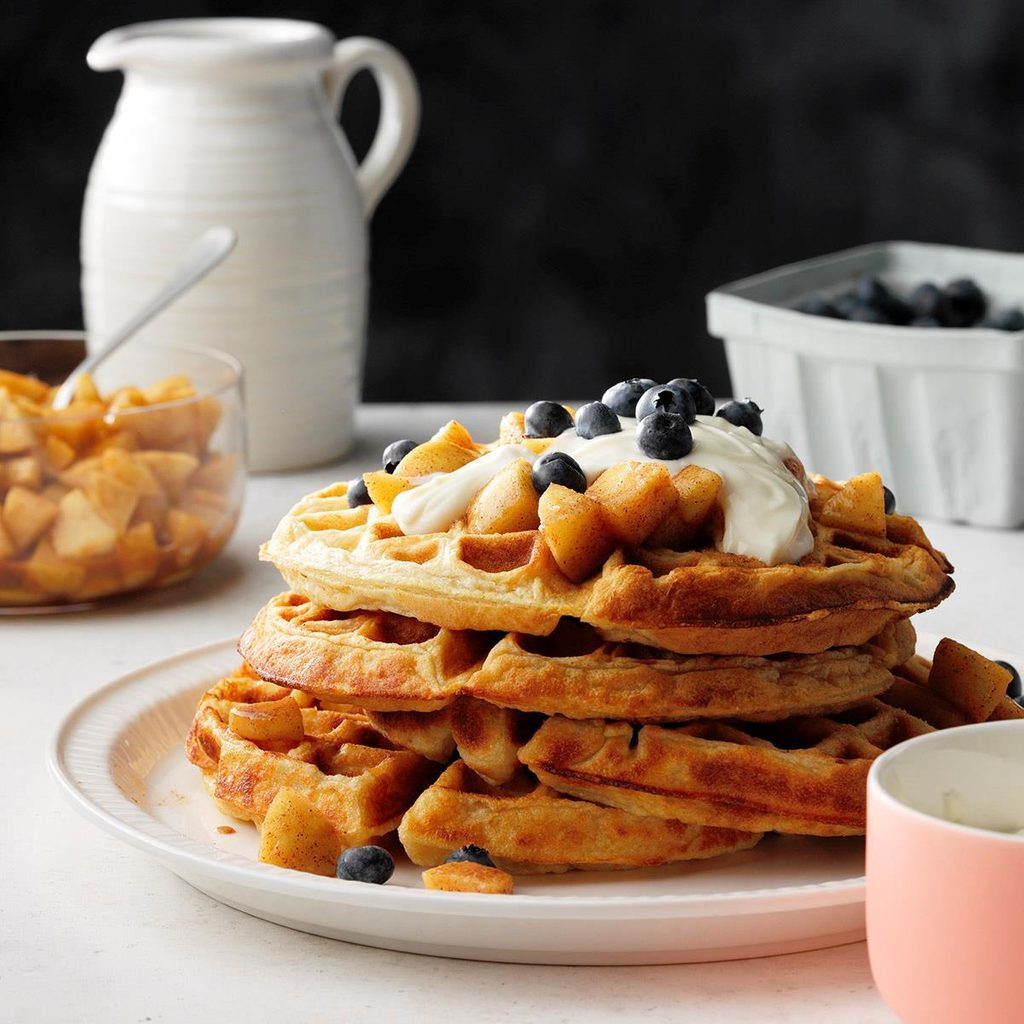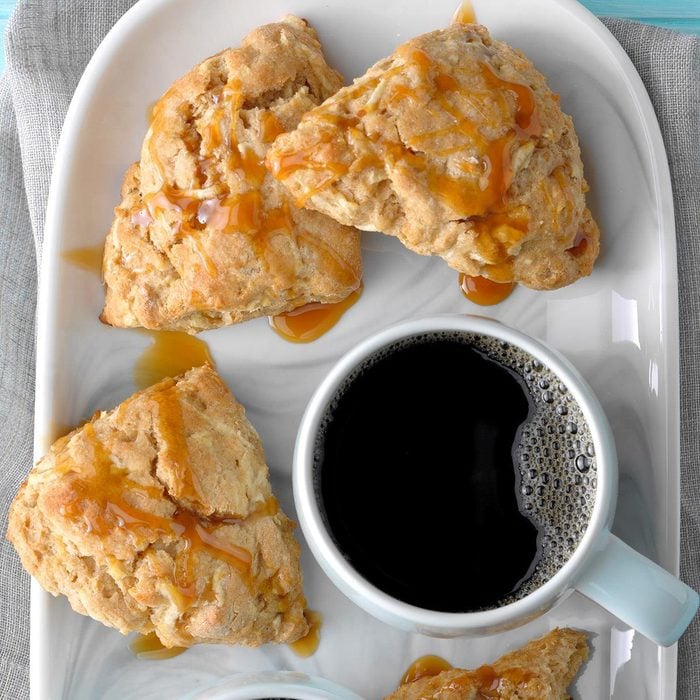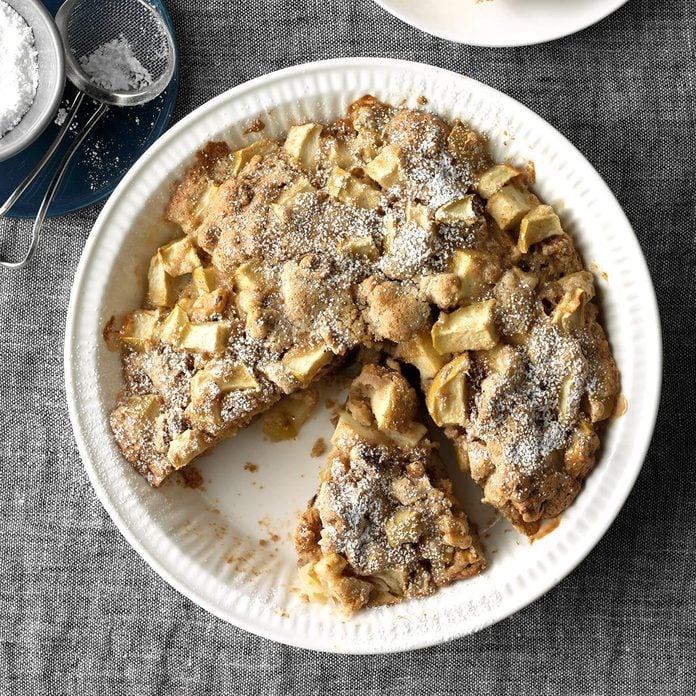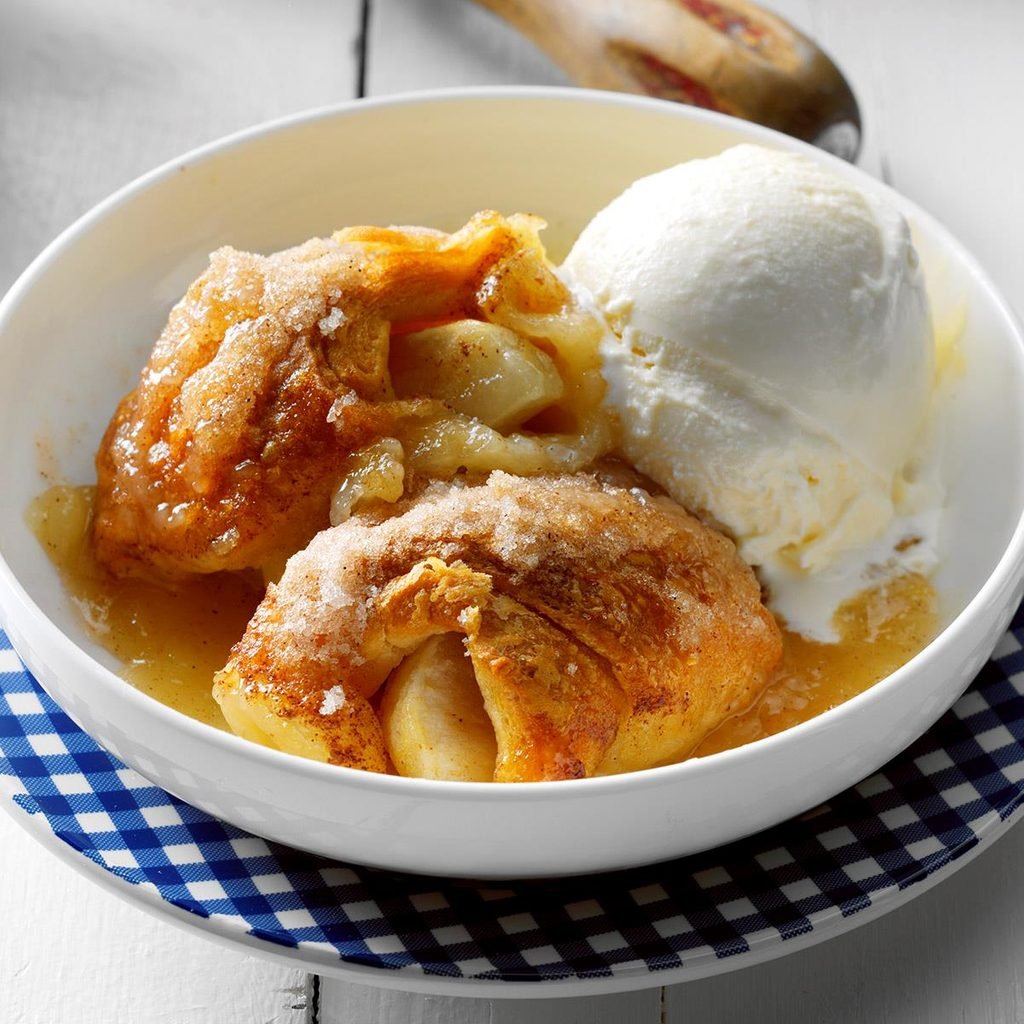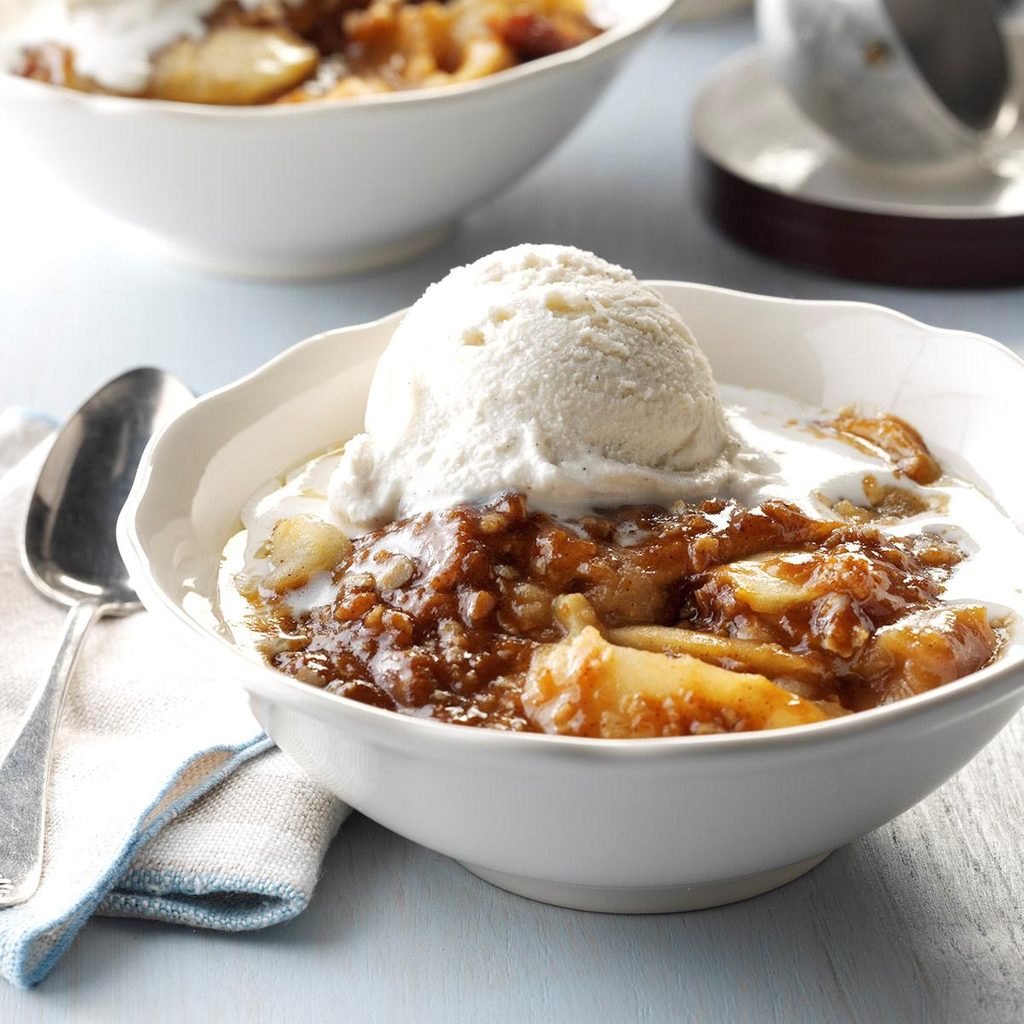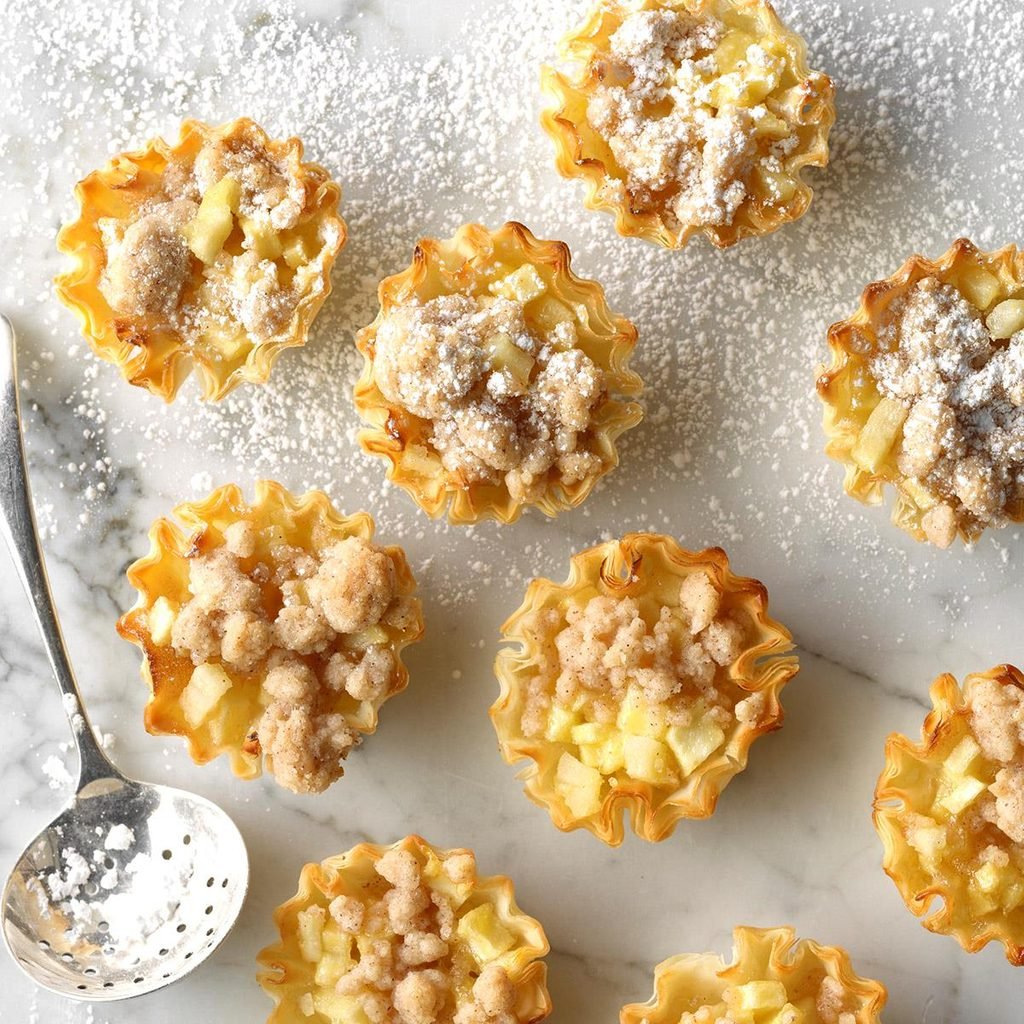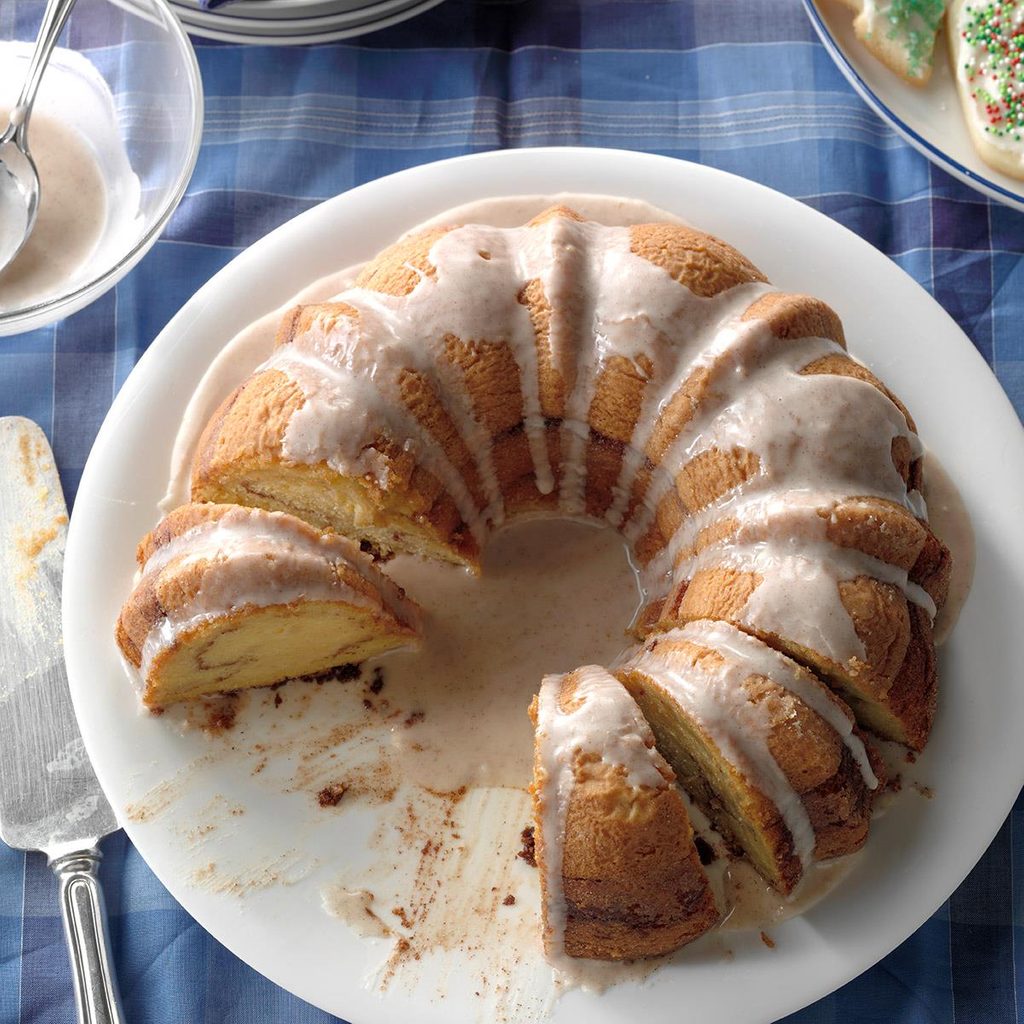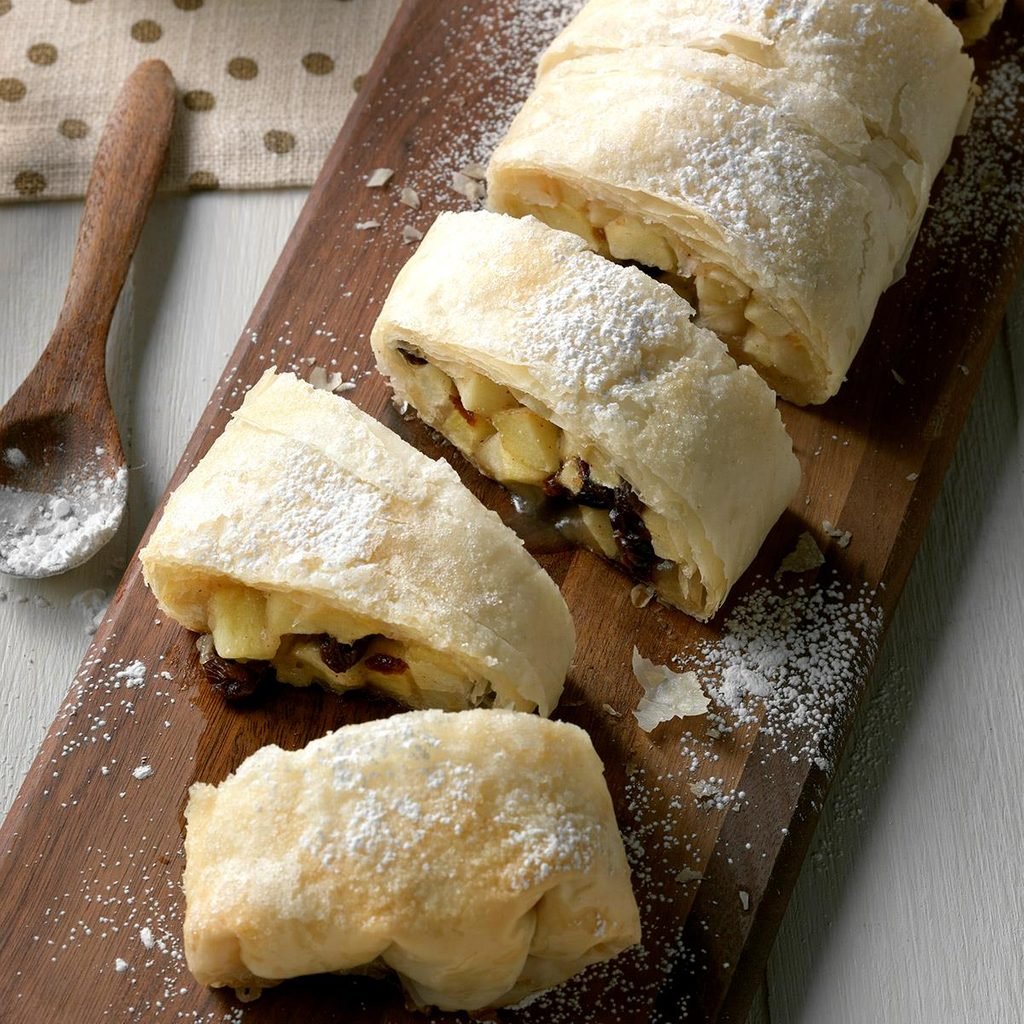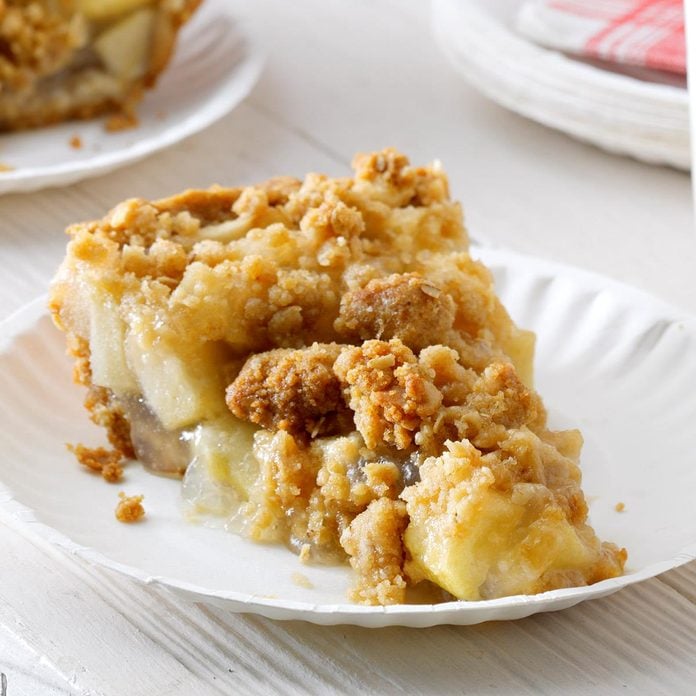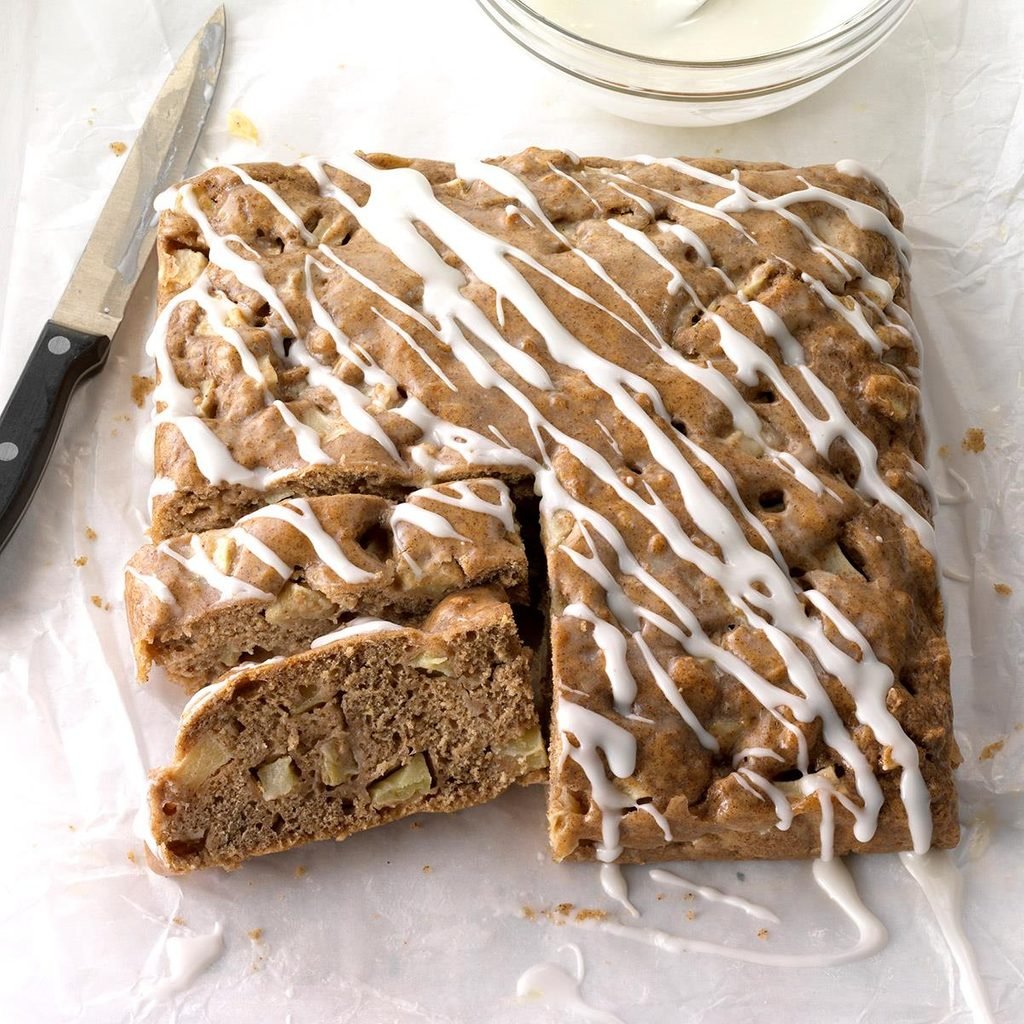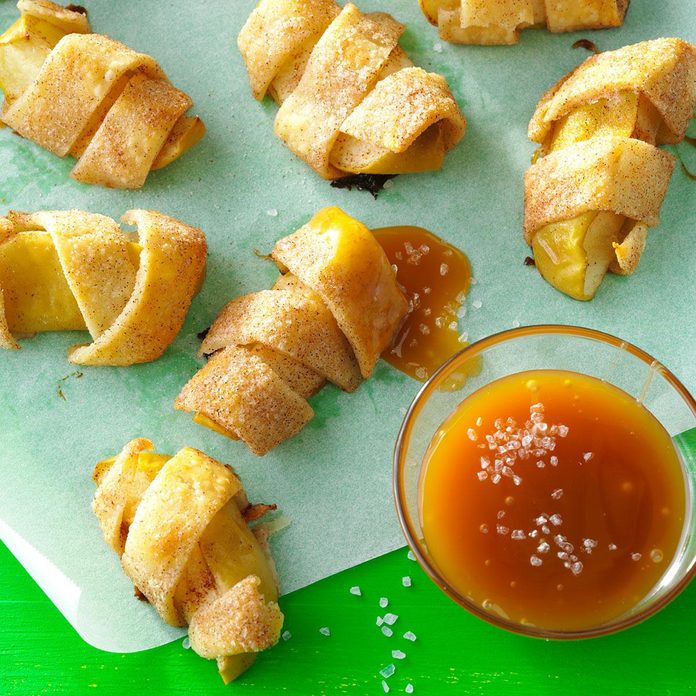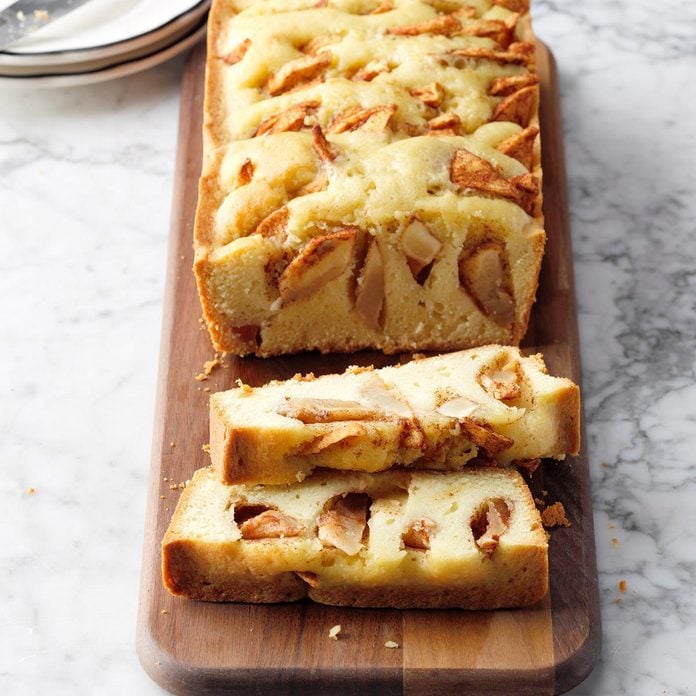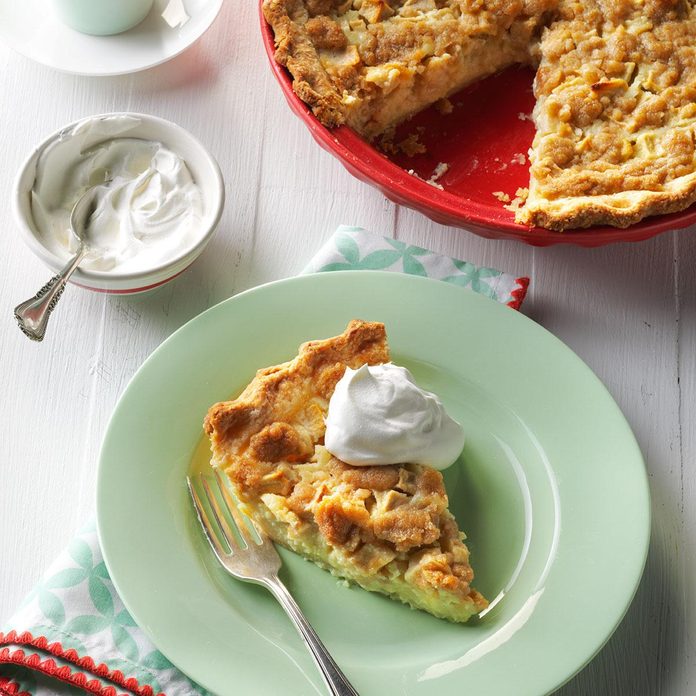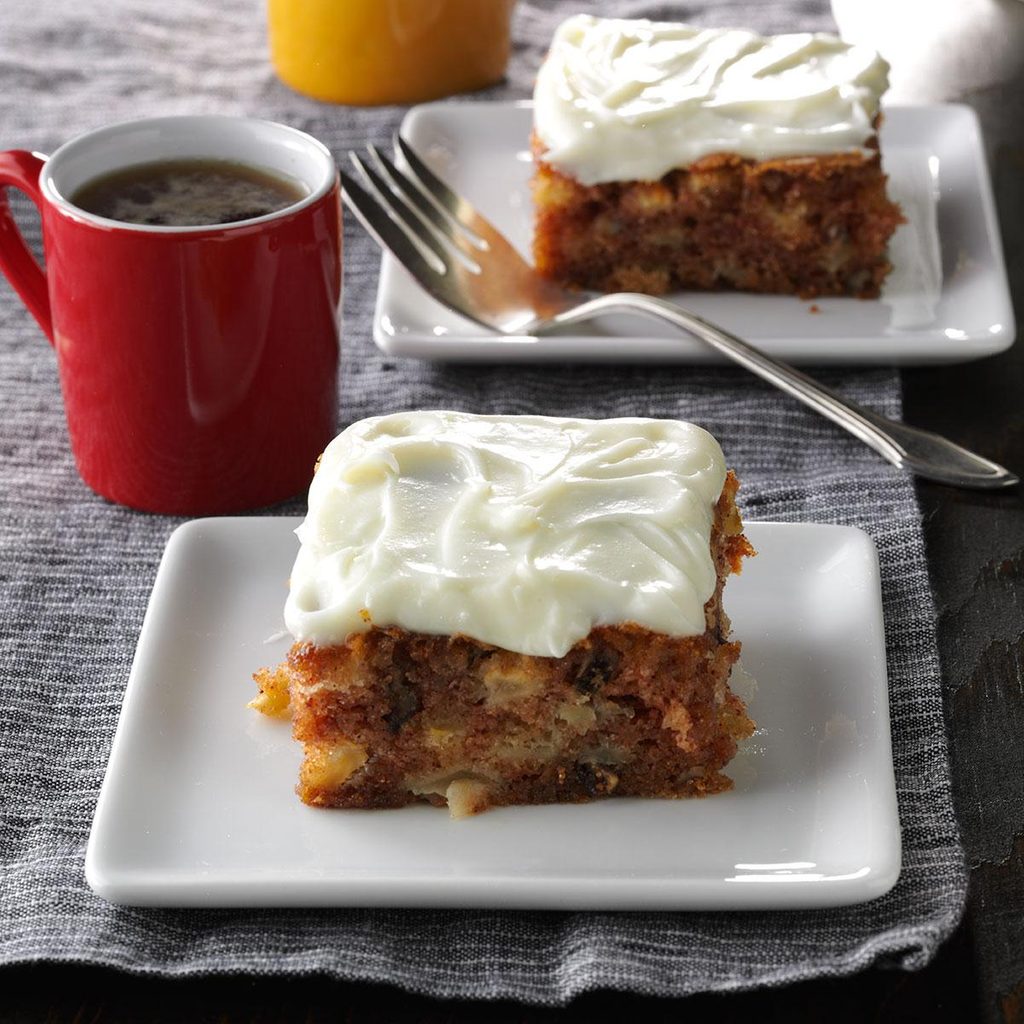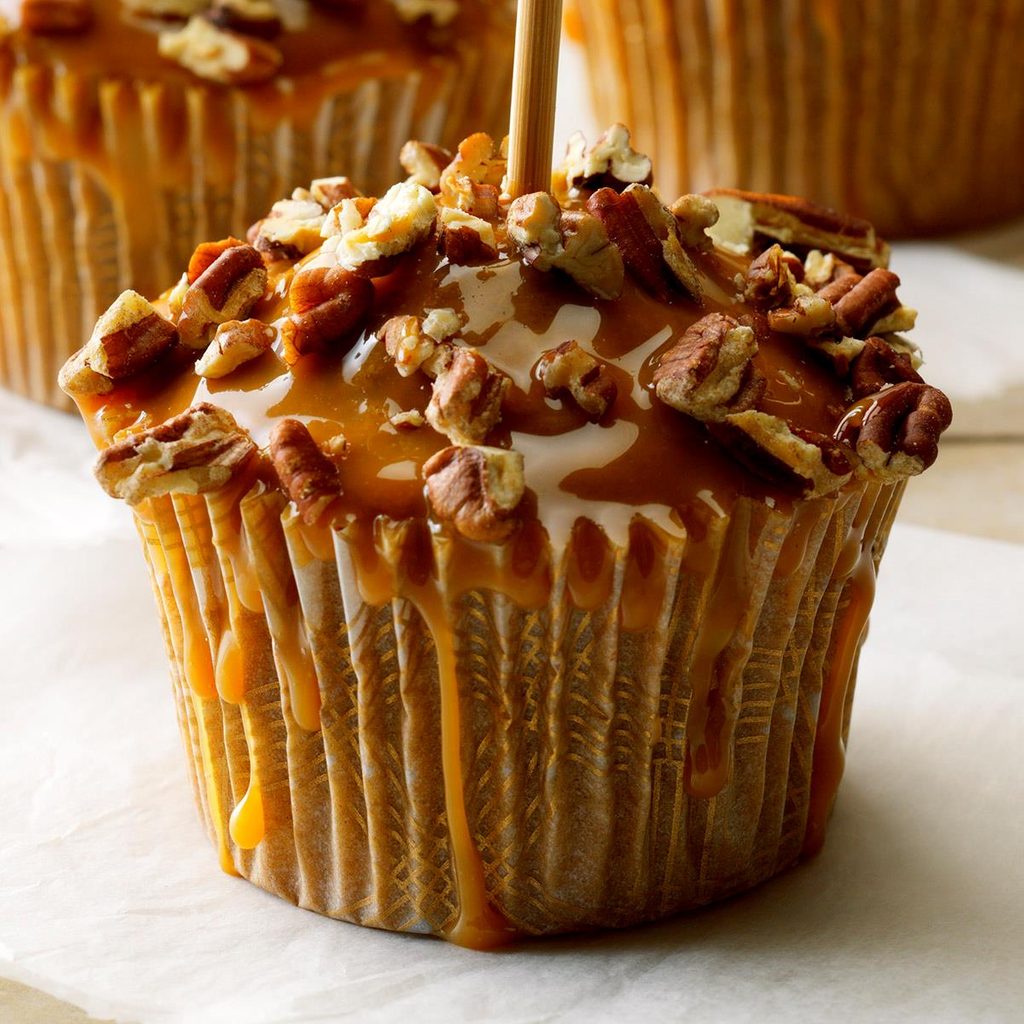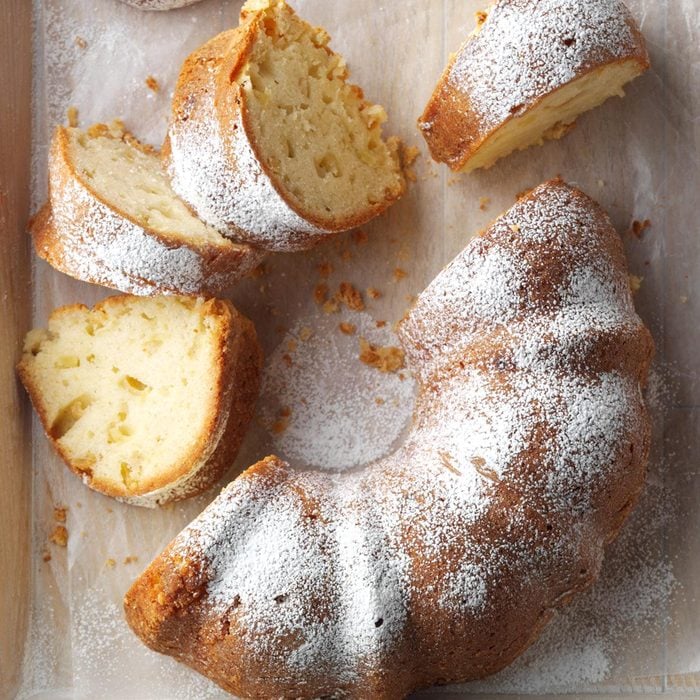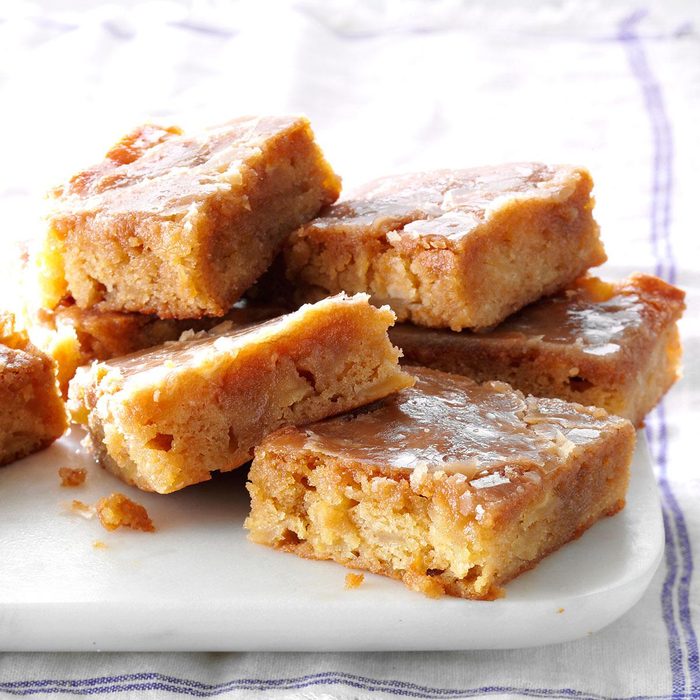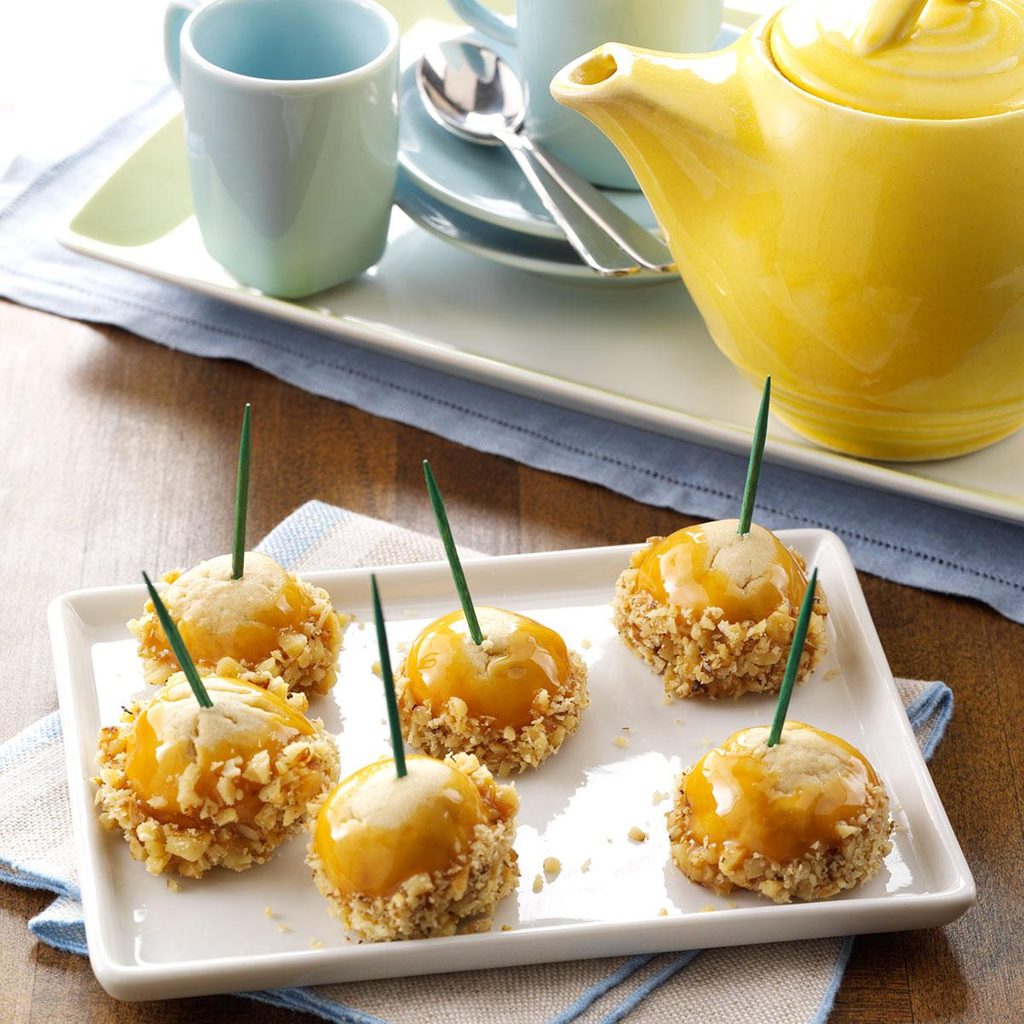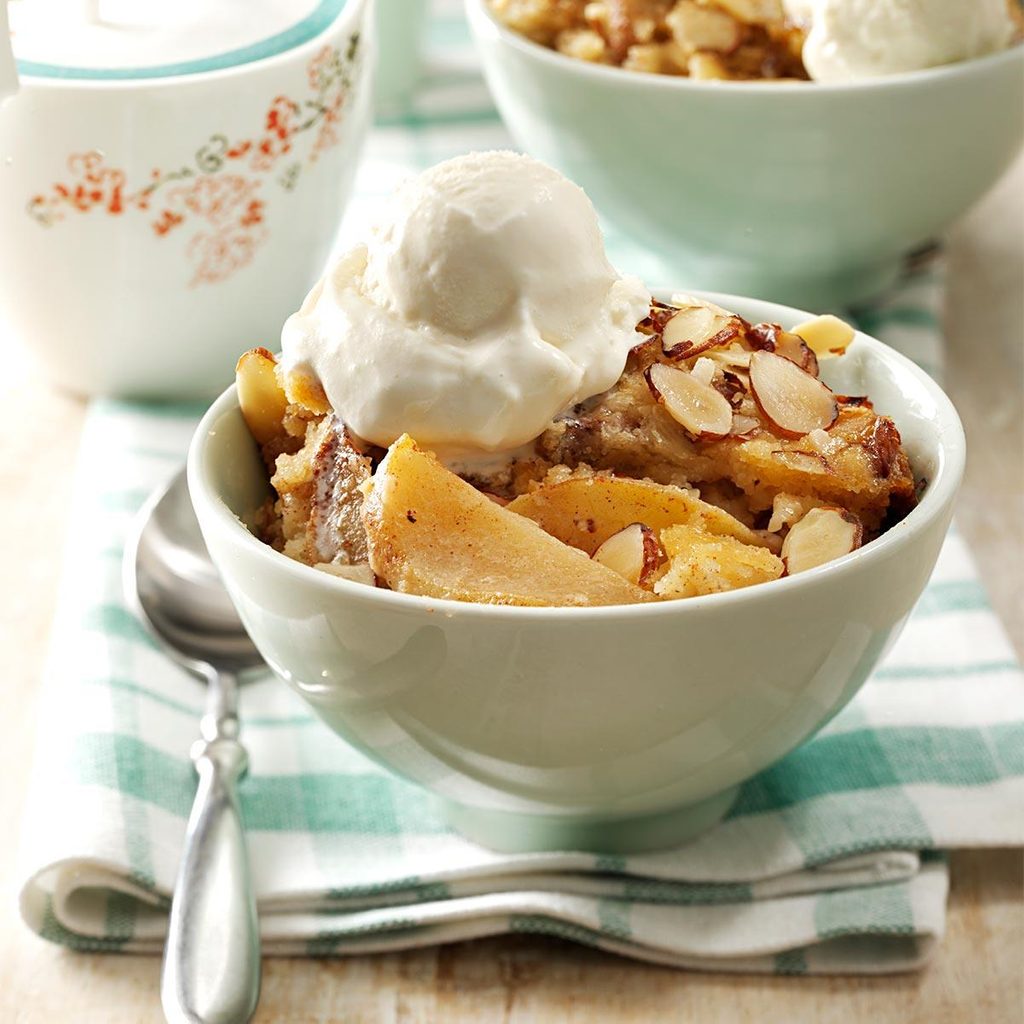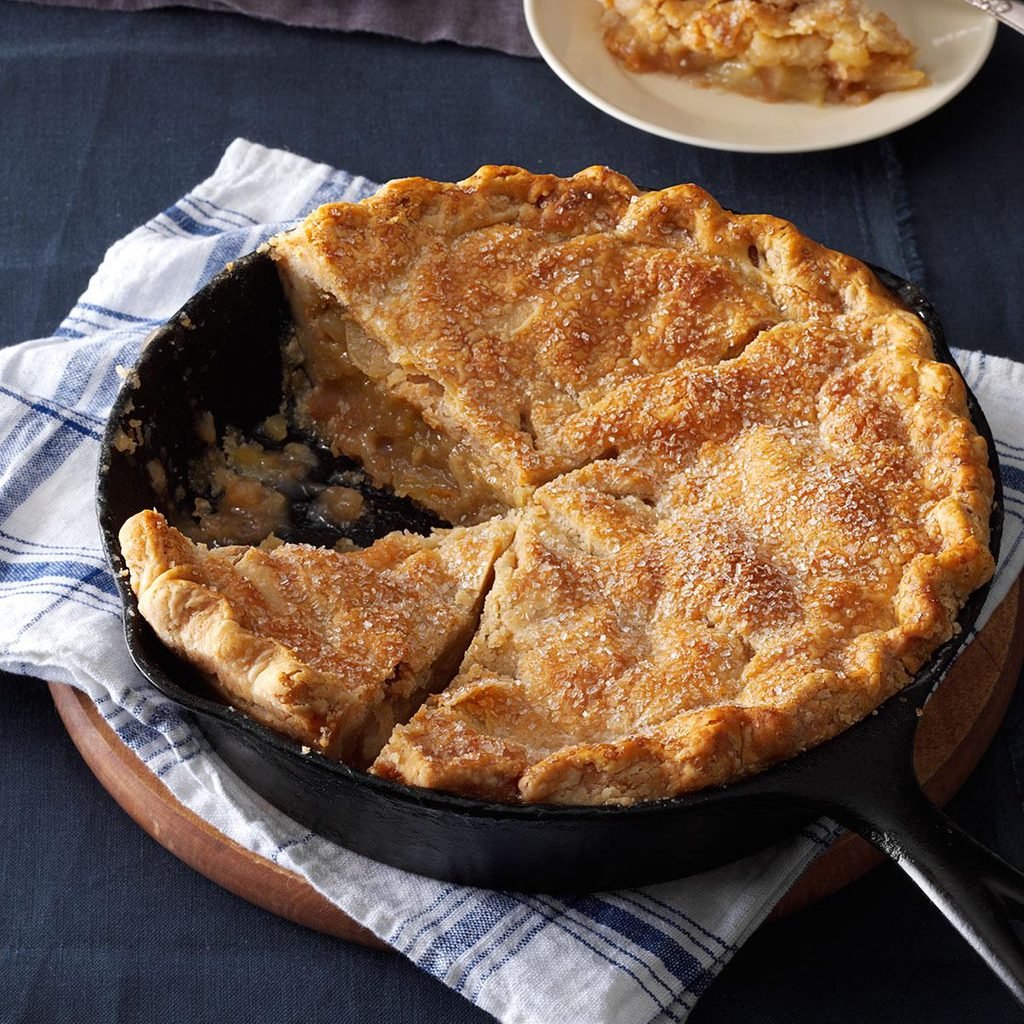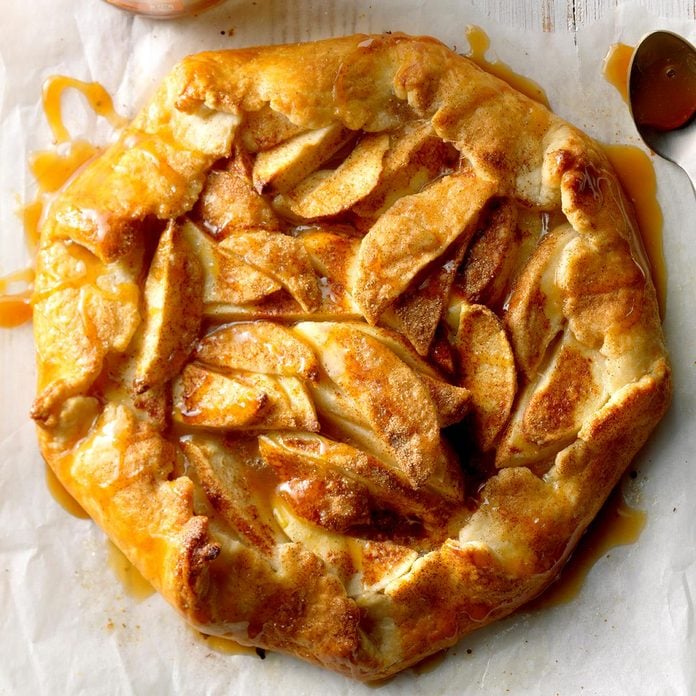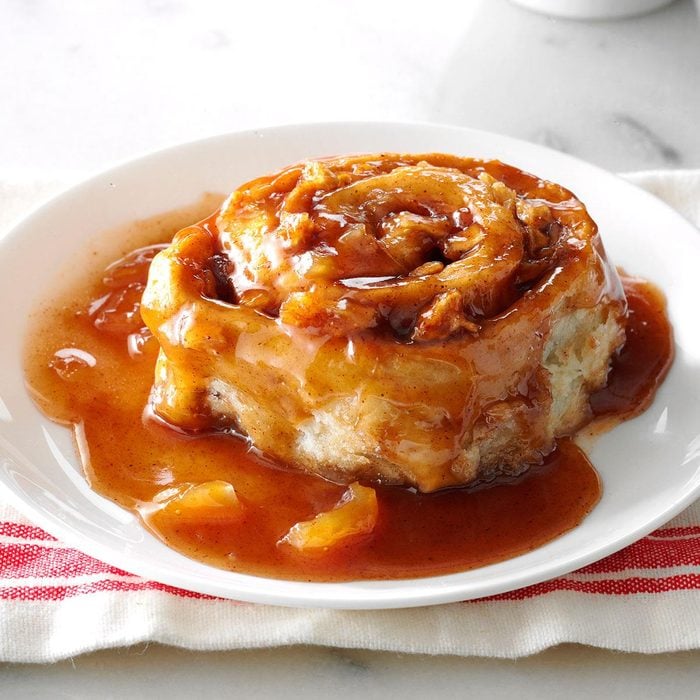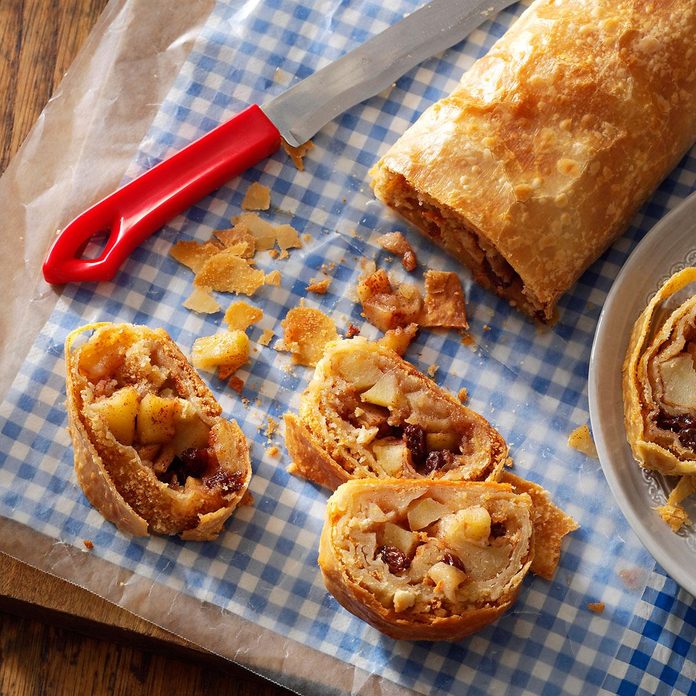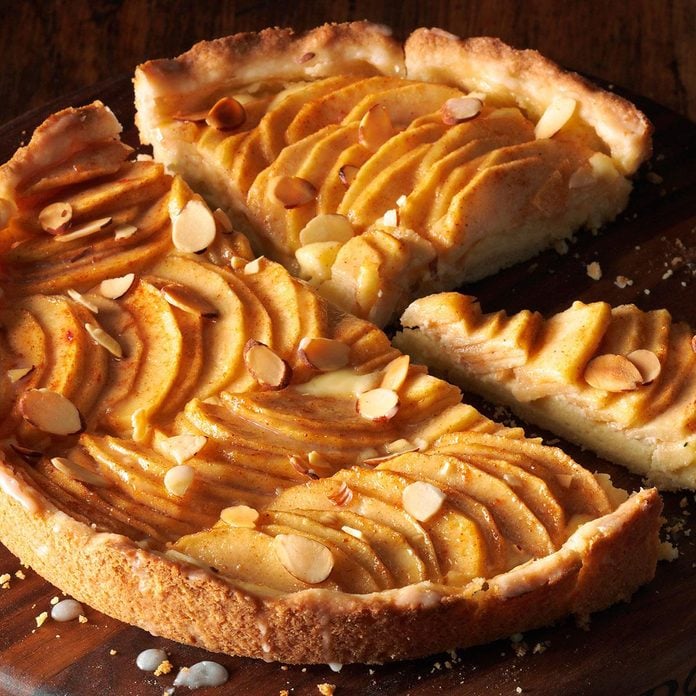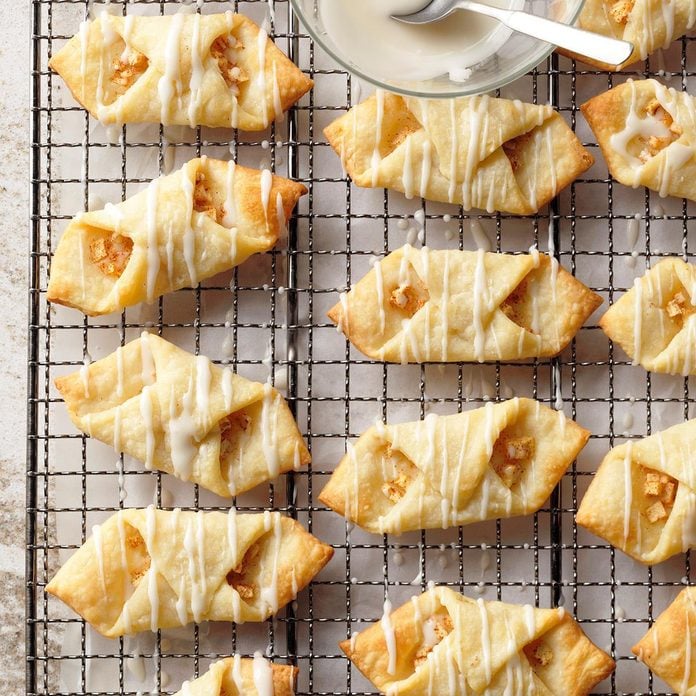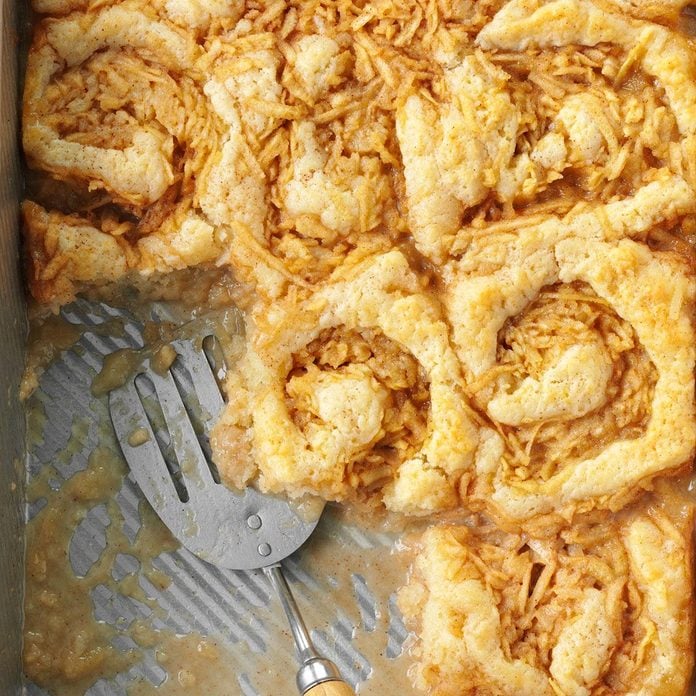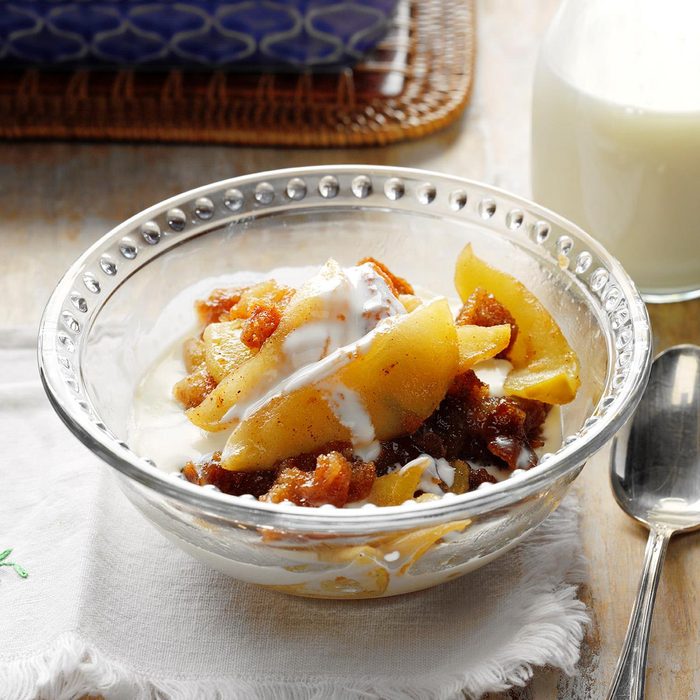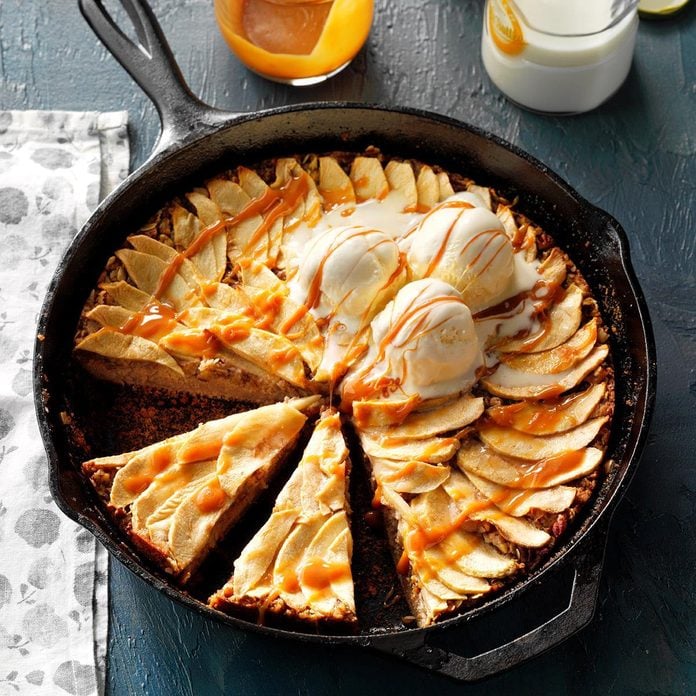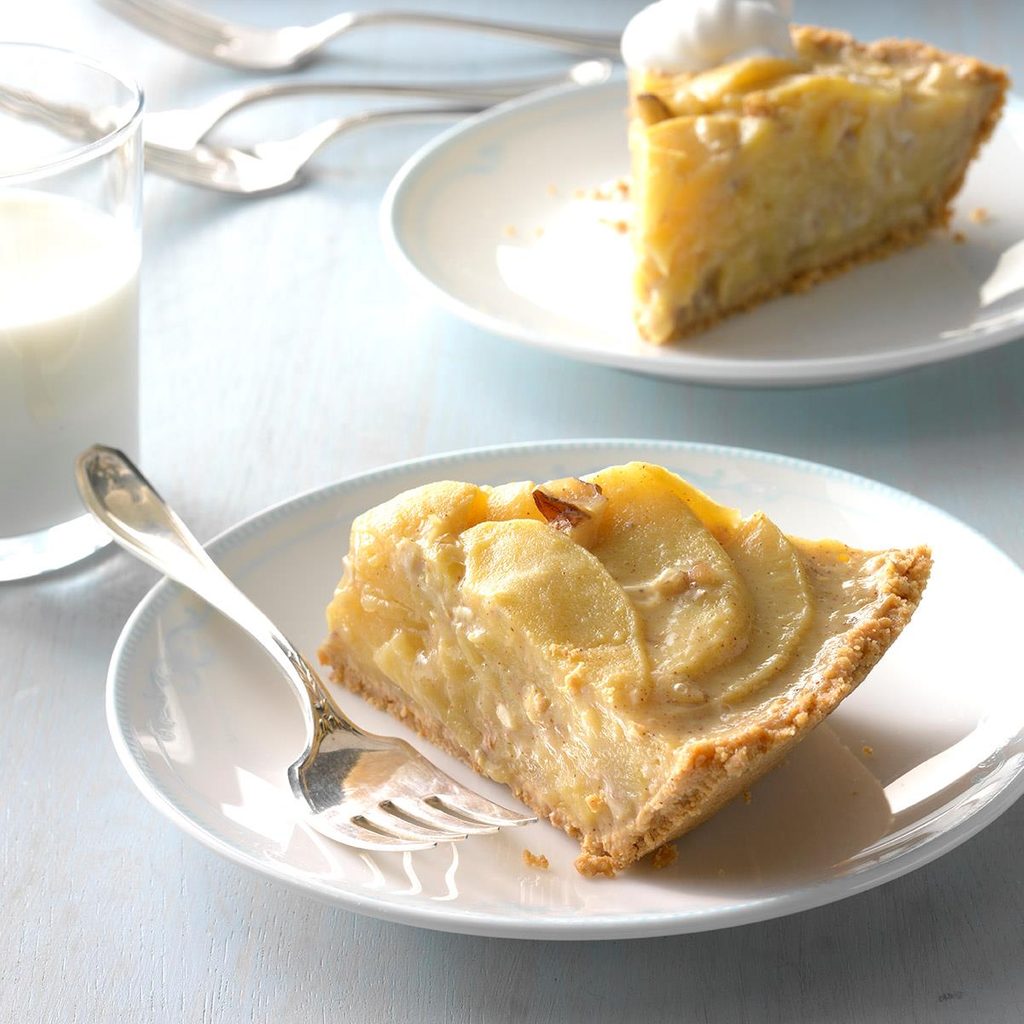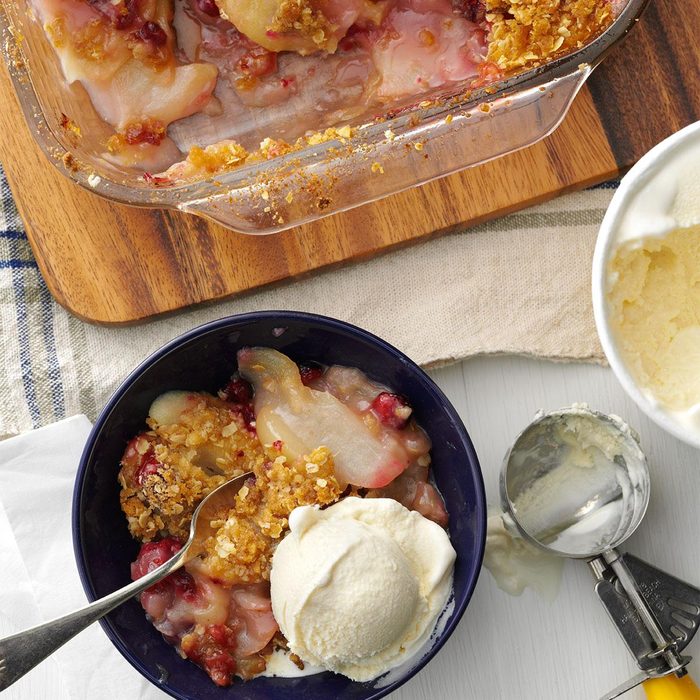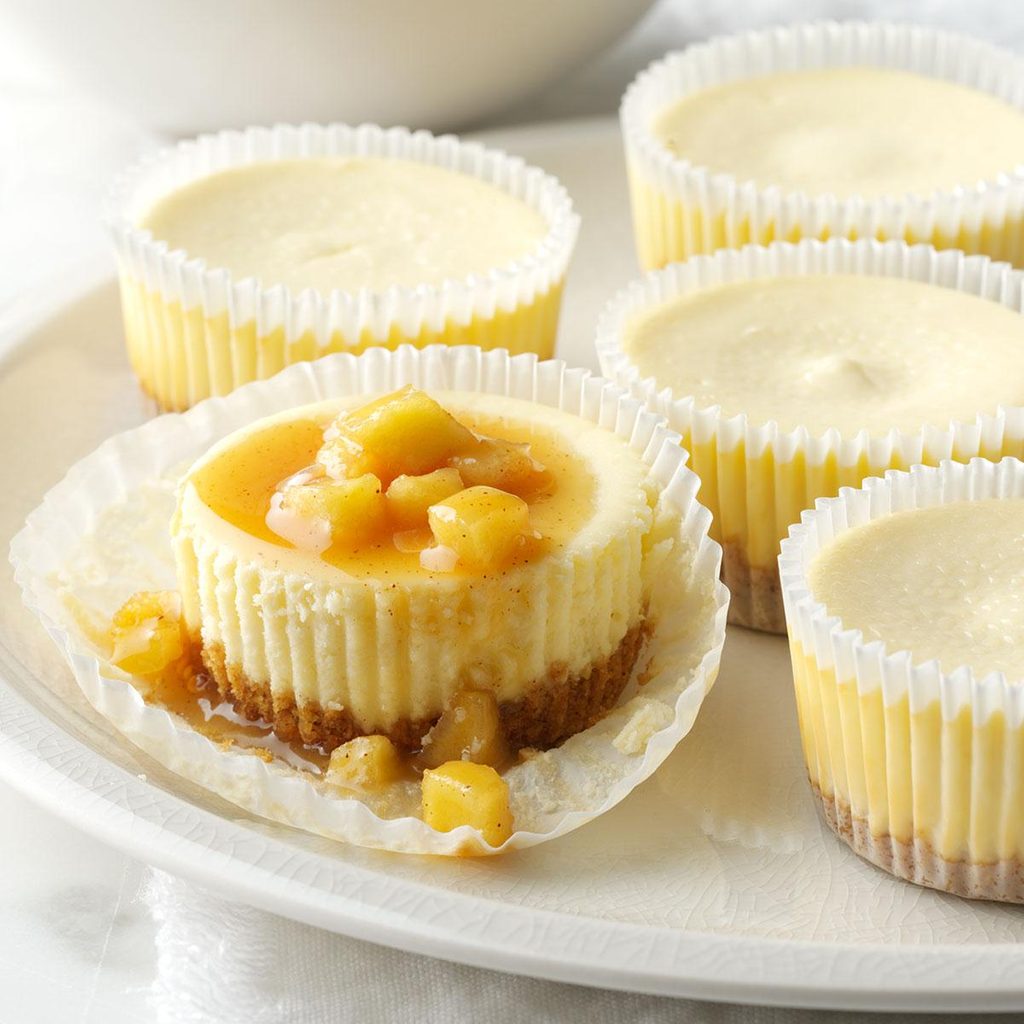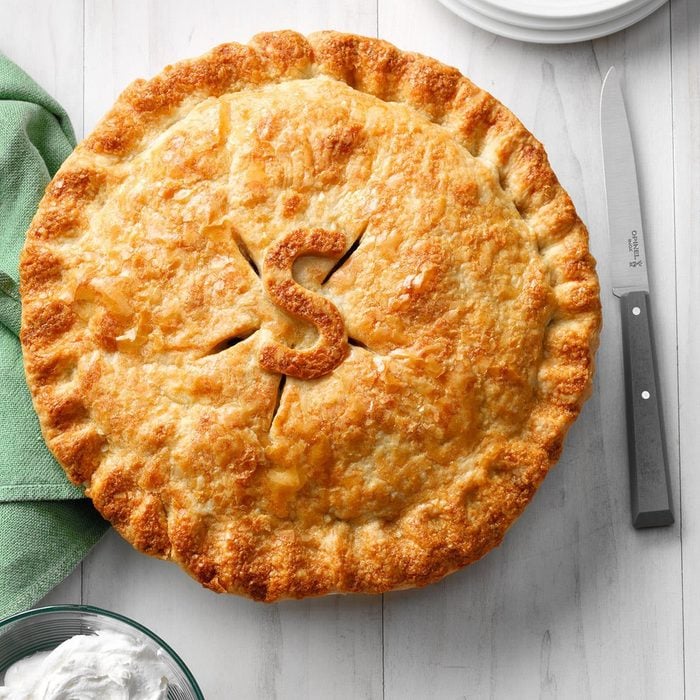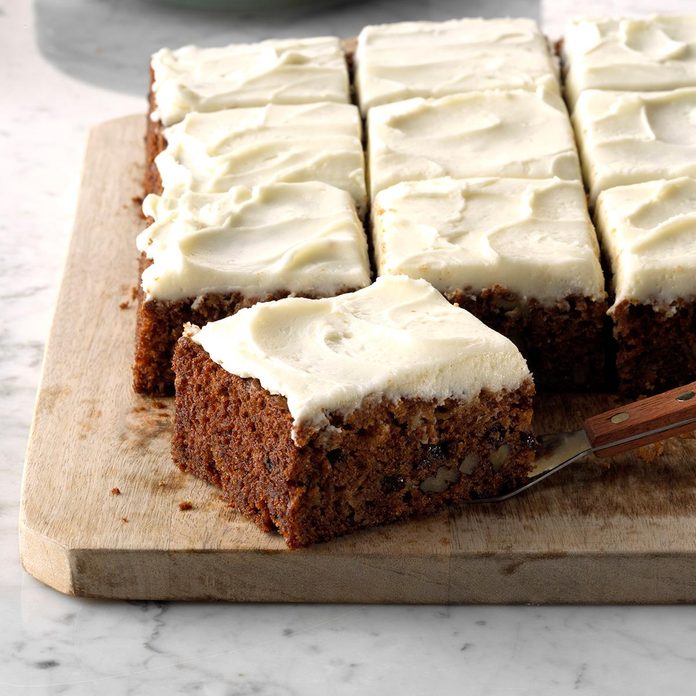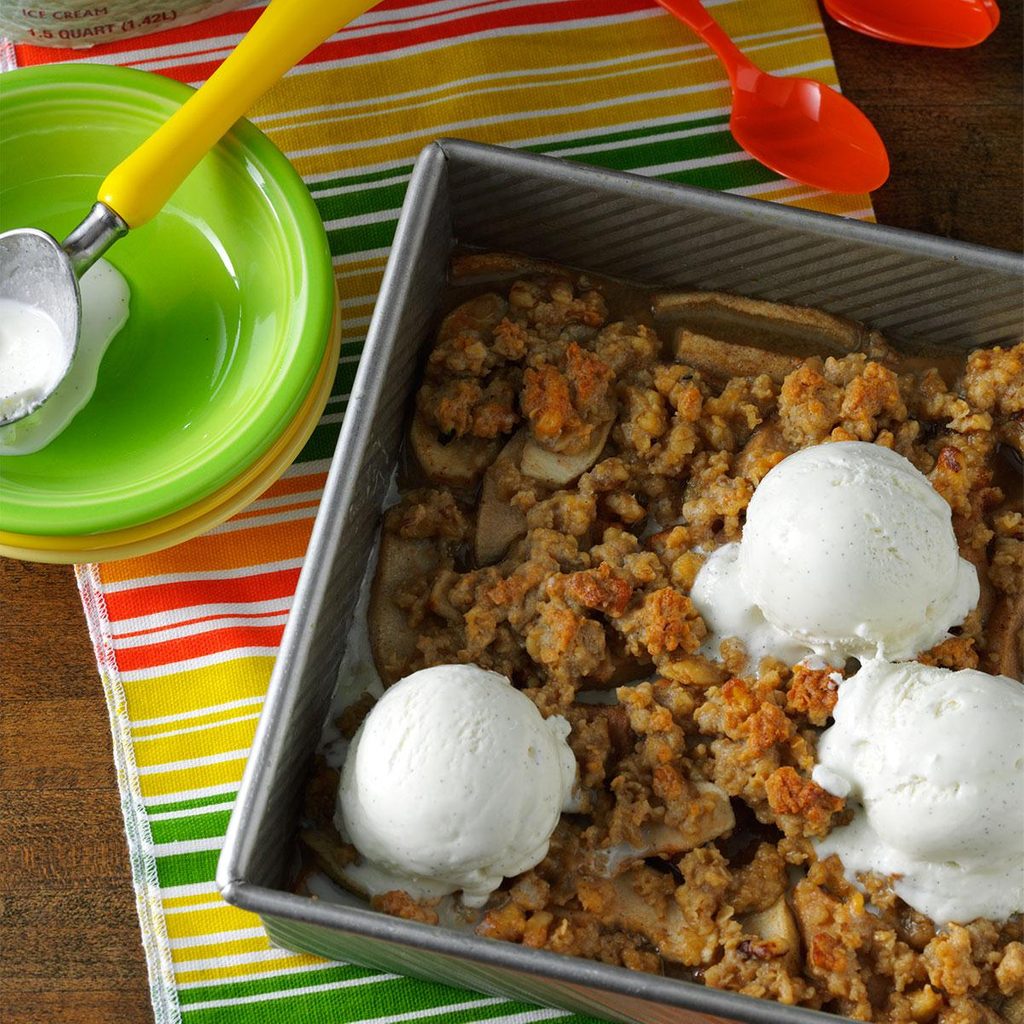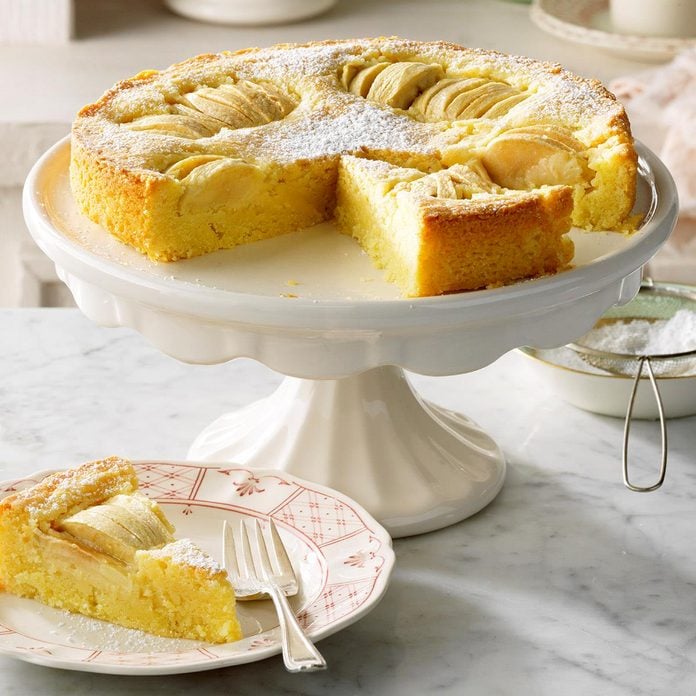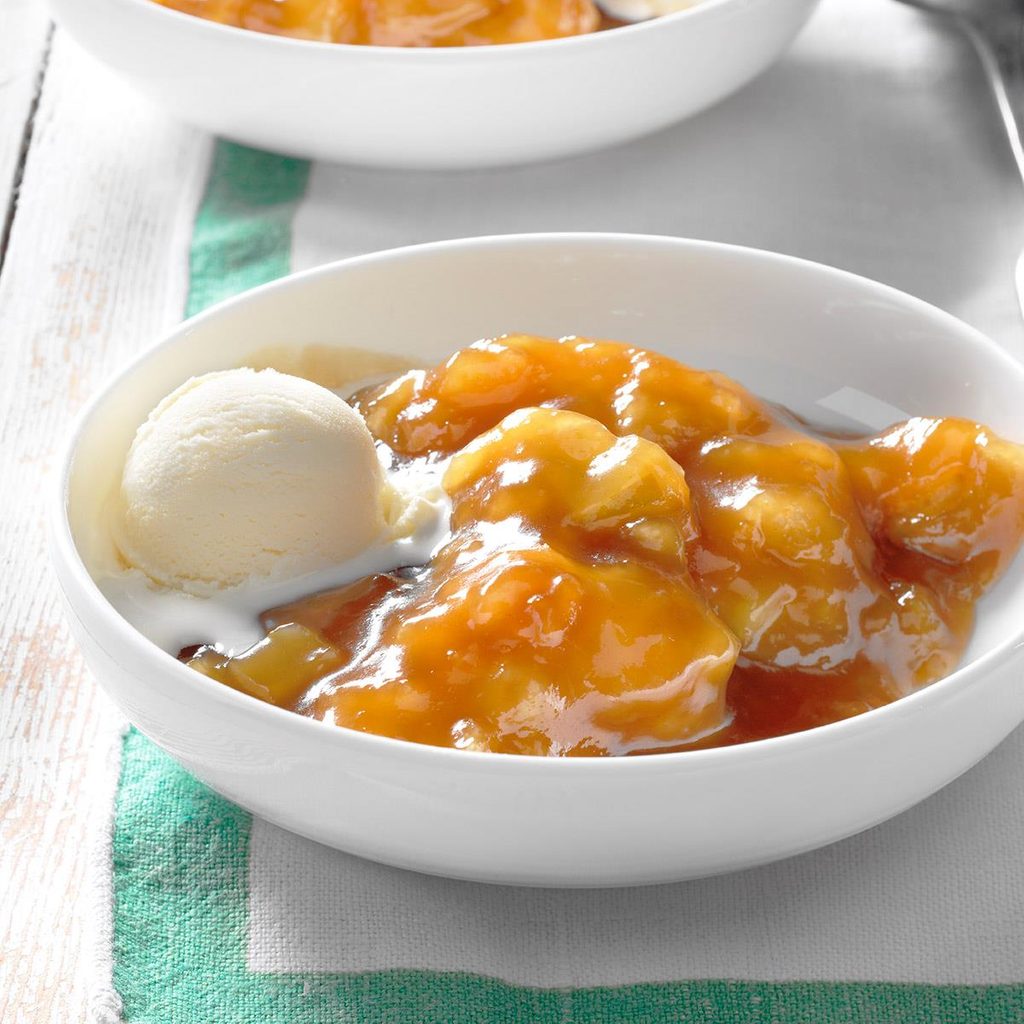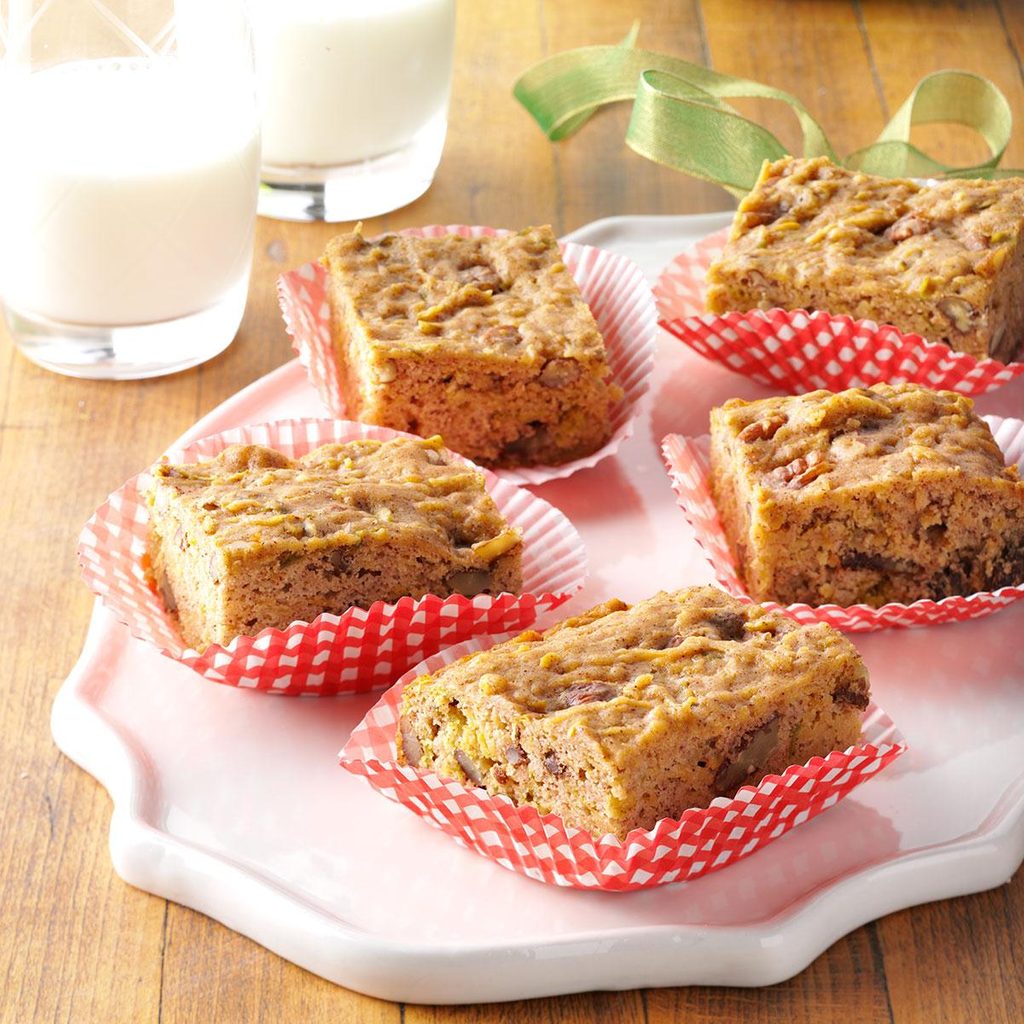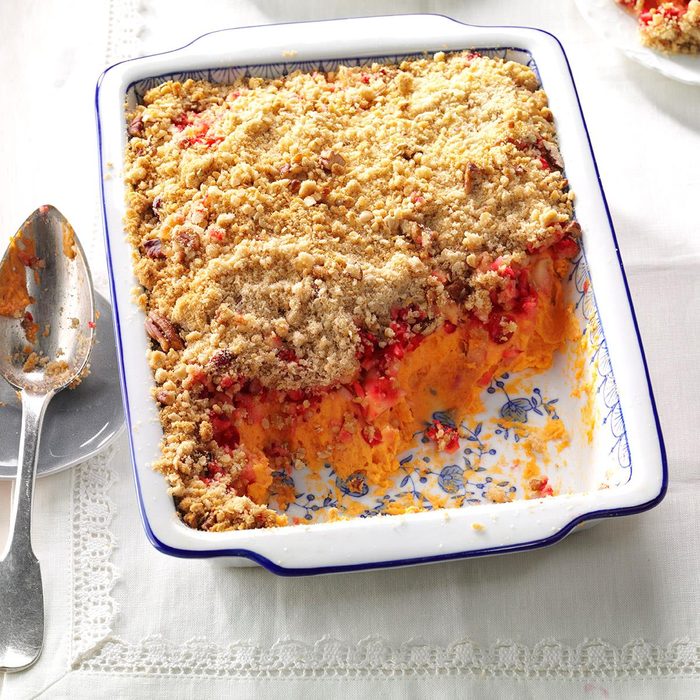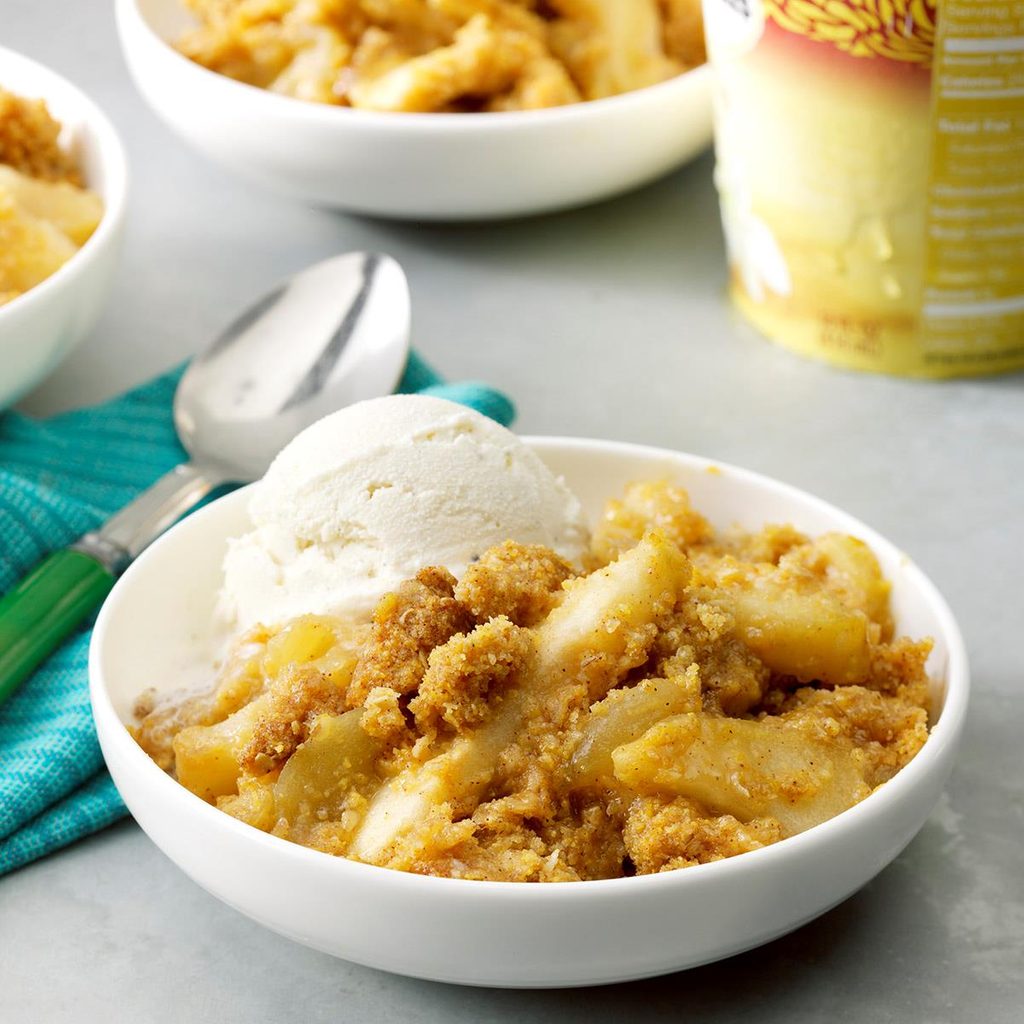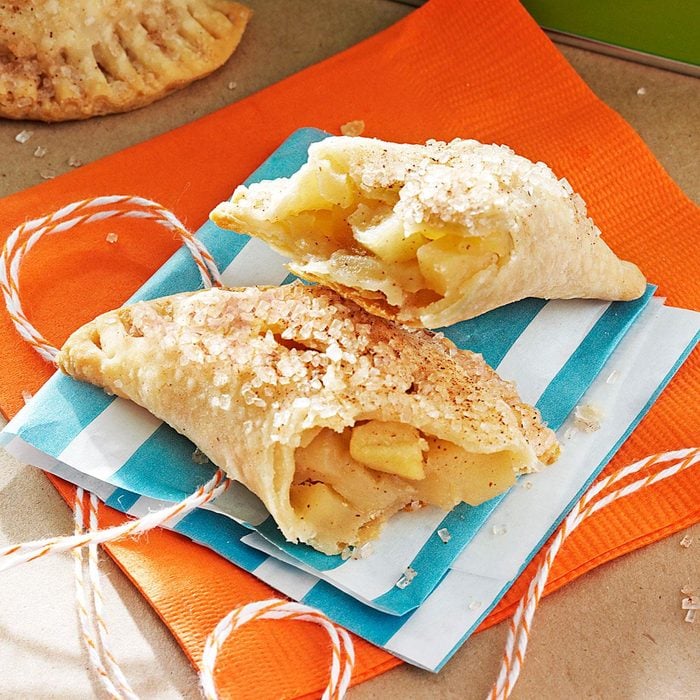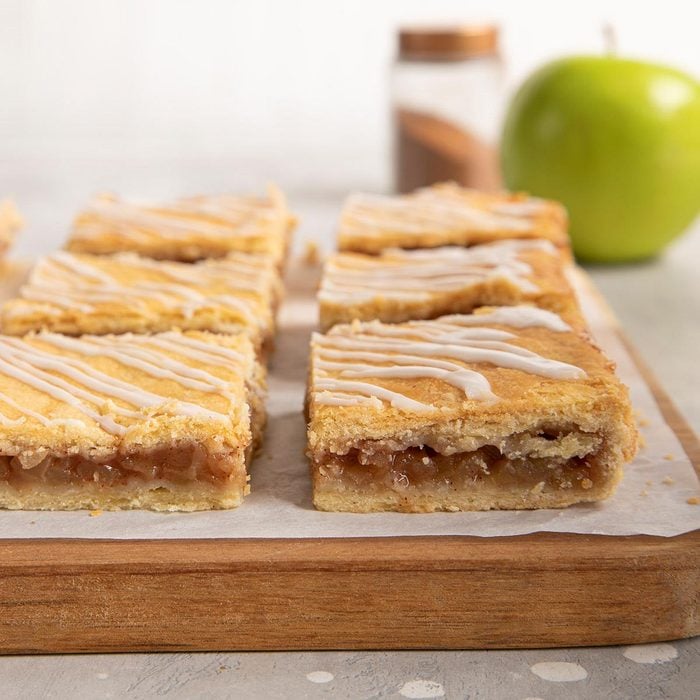Apple Crisp Pizza
While visiting a Wisconsin orchard, I tried a tempting apple crisp pie. At home, I put together this apple pizza. As it bakes, the enticing aroma fills my kitchen, and friends and family linger waiting for a sample. —Nancy Preussner, Delhi, Iowa
Get Recipe
Easy Apple CakeAfter testing many
apple cake recipes with fresh apples, I found this old-fashioned easy apple cake that is moist, dense and down-home delicious. Even better, it's quick to fix, and when it's served warm with whipped cream or a dollop of frozen custard, it's one of my family’s very favorites. —Sherry Ashenfelter, Waterville, Ohio
Apple FrittersThis is an old southern apple fritter recipe. When we got home from a trip through the South years ago, I found the recipe among the brochures I brought back. I've been making these easy apple fritters ever since. —John Robbins, Springdale, Pennsylvania
Psst! Learn how to make
apple roses, too.
Dutch Oven Apple CobblerThis homey Dutch oven apple cobbler is always a big hit with my family and one of our favorite easy apple desserts. We like to serve it with ice cream or whipped cream. —Cindy Jajuga, Weed, California
Trying to stay away from overly indulgent dishes? These
healthy apple recipes are just what you need.
Apple Peanut Butter CookiesThese apple peanut butter cookies are great for fall gatherings. They're crisp on the outside and soft inside. —Marjorie Benson, New Castle, Pennsylvania
Baked Apple SlicesNothing beats these tender baked apple slices over ice cream for satisfying harvest flavor. This old-fashioned treat gives a new twist to traditional baked apples. They are also excellent served over waffles or with ham. I make sure to save room for dessert! —Linda Gaido, New Brighton, Pennsylvania
Cast-Iron Apple Nutmeg Coffee CakeI'm not a great baker, but I do love coffee. In an effort to practice my baking, I use up the morning's last bit of coffee to make this cake—literally. It is super moist and crumbly, and tastes as if you dunked your cake right into a cup of hot joe. —Darla Andrews, Schertz, Texas
Apple-Sweet Potato Pecan Dump CakeThis quick cake has lots of delicious apples, sweet potatoes, spices, pecans and caramel. My surprise ingredient of white cheddar cheese enhances the wonderful filling. —Kathy Specht, Clinton, Montana
Apple Bread Pudding with Caramel SauceThis apple bread pudding with caramel sauce has been in my life for a long time. It's a family fave and always on my buffet when I put together a brunch. It's also special enough for dinner dessert. —Cleo Gonske, Redding, California
Slow-Cooked Pumpkin Apple CobblerThis spiced cobbler with apples and cranberries is sure to please all of your holiday guests. It is perfect for fall but can be made year-round since it uses fresh or frozen cranberries. —Joan Hallford, North Richland Hills, Texas
Air-Fryer Apple FrittersThese easy air-fryer apple fritters with brown butter glaze are healthier than old-fashioned fritters, yet they are still as delicious. Plus they're made in under 30 minutes for a quick and easy apple dessert! —Alyssa Castriotta, North Scituate, Rhode Island
Apple Spice Cake with Brown Sugar FrostingI am a healthy eater most of the time, but this apple spice cake is worth the splurge! Every year I treasure the opportunity to make my own birthday cake, and I choose this. You can add a cup of raisins to the batter before baking if you'd like. —Jennifer Owen, Louisville, Kentucky
Slow-Cooker Apple Pudding CakeA satisfying dessert like this is a superb treat on a chilly night. It has three layers—apples, cake and sauce—and I like to serve it in a bowl. It's comfort food for the soul. —Ellen Schroeder, Reedsburg, Wisconsin
Apple ComfortYears ago, we were without electricity for nine days during an ice storm, but I was able run the slow cooker from our generator. The situation called for a treat, and this has been a favorite ever since.
Mom's Fried ApplesMom often made these rich cinnamon-sugar apples when I was growing up. I swear the folks at Cracker Barrel copied her recipe! —Margie Tappe, Prague, Oklahoma
Butterscotch Apple CakeMy family often requests this easy old-fashioned cake for get-togethers—especially in the fall. It's one of our favorite easy apple desserts. —Beth Struble, Bryan, Ohio
Apple BreadI got this apple quick bread recipe a long time ago and with a few changes it's become one of our favorites. Everyone who's ever tasted this apple bread has asked for the recipe! —Phyllis Herlocker, Farlington, Kansas
Apple Streusel BarsI made these delicious bars for a friend's birthday once and now he requests them every year! They have a tasty tartness with a cinnamony kick. Be sure to chop the apples into small cubes —if the apple pieces are too big the bars will fall apart. —Danielle Millwer, Tonawanda, New York
Apple Coffee CakeTart sour cream flavors this moist apple cinnamon coffee cake covered with brown sugar and crunchy nuts. The yield is two pans, so you can serve one and freeze the other for a busy morning or unexpected company. —Dawn Fagerstrom, Warren, Minnesota
Oatmeal Caramel Apple CookiesThis recipe for caramel apple cookies is a fun twist on traditional oatmeal raisin. These treats are hard to resist! —Rachel Lewis, Danville, Virginia
Apple-Walnut Cake with Orange GlazeI tinkered with a plain apple cake recipe to create this moist, delicious winner. The result: old-fashioned goodness with a heavenly aroma! This cake is the perfect fall treat or holiday dessert, but it’s also great as a special breakfast or brunch item. —Lisa Speer, Palm Beach, Florida
Caramel Apple BarsThese bars make an excellent fall dessert. We like to warm individual servings in the microwave and serve with a scoop of vanilla ice cream. It quickly became a family favorite; maybe it'll become one of your family's, too. —Carol Stuber, Osawatomie, Kansas
Apple Slab PieApple slab pie is a terrific contribution to a covered-dish supper, picnic or potluck. It’s baked in a large 15x10 baking pan so it’s easy to make and tote, too. But be prepared—people always ask for a copy of the recipe! —Dolores Skrout, Summerhill, Pennsylvania
Apple-Nut Bread PuddingTraditional bread pudding gives way to autumn's influences in this comforting, easy apple dessert. I add apples and pecans to this slow-cooked version, then top warm servings with ice cream. —Lori Fox, Menomonee Falls, Wisconsin
Chunky Apple-Cinnamon CakeThis is a nice change from apple pie. It's tasty and worthy of a special occasion—plus, it’s very easy to make. —Ellen Ruzinsky, Yorktown Heights, New York
Apple Dumpling Pull-Apart BreadI converted a basic sweet dough into this incredible apple-filled pull-apart loaf. The results are anything but basic. It takes time but I guarantee it's worth it. Using both sauces is twice as tasty. —Gina Nistico, Denver, Colorado
Apple Cranberry Upside-Down CakesCornmeal gives this upside-down cake a unique texture. Apples, cranberries and pecan make a delicious alternative to the typical pineapple and cherries. —Margee Berry, Trout Lake, Washington
Apple Gingerbread Skillet CakeThis gingerbread recipe came from my grandmother, and we always ate it with warm applesauce. I adapted it into a one-pan dessert by layering the apples around the bottom of a cast-iron skillet and topping them with the gingerbread batter. The skillet creates a wonderfully thick crust on the gingerbread. —Mary M. Leverette, Columbia, South Carolina
Apple Pie Cupcakes with Cinnamon ButtercreamThese apple pie cupcakes are always a hit! They are so easy to make and the flavor just screams fall. Of course, they're equally delicious any other time of year. —Jennifer Stowell, Deep River, Iowa
Caramel ApplesNothing tastes better at this time of year than a sweet-to-eat caramel apple! That rich homemade flavor just can't be beat.—Karen Ann Bland, Gove, Kansas
Easy Pennsylvania Dutch Apple CobblerThis is a common dish from where I was born and raised in Pennsylvania. It's a classic Dutch-style apple cobbler recipe—easy, quick and delicious. Who wouldn't love this golden brown delight? —Andrea Robson, York, Pennsylvania
Cinnamon Apple Cider Monkey BreadI use the cold-weather staple apple cider—plus apples and more cinnamon—to turn plain cinnamon rolls into monkey bread. My boys love the sticky sweetness. —Kelly Walsh, Aviston, Illinois
Caramel Apple FloatWho doesn't love the flavors of caramel, apples, and vanilla ice cream together? If I'm feeling fancy, I drizzle caramel syrup around the inside of my glass before adding the apple cider and ginger ale. —Cindy Reams, Philipsburg, Pennsylvania
Swedish Cream Apple RingsMy mother made this classic coffee cake for every important holiday... Thanksgiving, Christmas and Easter. Now, I carry on the tradition. As I make them, I remember my mom, who was a lot like this recipe: soft and tasteful but full of surprises. The overnight rise let's you make the dough in advance so your morning won't be hectic.—Heather Hood, Hillsboro, Oregon
Apple Betty with Almond CreamI love making this apple betty for friends during the peak of apple season. I plan a quick soup and bread meal, so we can get right to the dessert! —Elizabeth Godecke, Chicago, Illinois
Apple Pie Ricotta WafflesI had apples and ricotta cheese to use up, so instead of making a pie I decided to do something different. The result was these fluffy, tender waffles with just a hint of sweetness. —Teri Rasey, Cadillac, Michigan
Caramel Apple SconesA drizzle of caramel complements the apple and whole wheat flavors of these rustic-looking scones. —Arlene Cook, Bainbridge, Georgia
Swedish Apple PieThis decadent Swedish apple pie serves up homemade flavor in every bite. This is a perfect snack with coffee or as an after-dinner treat. —Sarah Klier, Grand Rapids, Michigan
Apple Dumpling BakeI received this recipe for baked apple dumplings with Mountain Dew from a friend of mine, then tweaked it to suit my family's tastes. The soda is definitely the secret ingredient in this rich apple dessert. —Chris Shields, Monrovia, Indiana
Apple Butterscotch CrispI give this classic dessert a rich twist with butterscotch pudding. The warm apple filling bubbles to perfection in a mini slow cooker. —Jolanthe Erb, Harrisonburg, Virginia
Dutch Apple Pie TartletsThese adorable mini apple pie pastries make a delightful addition to a dessert buffet or snack tray. The recipe calls for convenient frozen phyllo shells, so they're surprisingly easy to prepare. The lemon curd filling adds a unique flavor twist. —Mary Ann Lee, Clifton Park, New York
Apple Cinnamon CakeThis apple cinnamon cake is equally good for breakfast or dessert, so be sure to not eat all of it after dinner! Easy to make, it's super moist on the inside and has a crispy, cinnamon-rich crunch on the outside. —Marideane Maxwell, Albany, Georgia
Caramel Apple BarsThese bars make an excellent fall dessert. We like to warm individual servings in the microwave and serve with a scoop of vanilla ice cream. It quickly became a family favorite; maybe it'll become one of your family's, too. —Carol Stuber, Osawatomie, Kansas
Easy Apple StrudelMy family always loves it when I make this wonderful dessert. Old-fashioned strudel was too fattening and time-consuming, so I changed it up a bit. This revised classic is just as good as the original. It's best served warm from the oven. —Joanie Fuson, Indianapolis, Indiana
Winning Apple CrispI live in apple country, and making a delicious apple crisp is one way to use the fruit. This treat doesn’t take a lot of time to assemble. —Gertrude Bartnick, Portage, Wisconsin
Favorite Dutch Apple PieEverything about this easy apple dessert (but especially its topping!) makes it the number 1 request for family gatherings. Its oat crust reminds me of a cookie, and the tart apple filling just can't be beat during harvest time. —Brenda DuFresne, Midland, Michigan
Apple Fritter CakeI was experimenting with a beer bread to make it into a dessert and came up with this delectable apple fritter cake. —Ann Marie Eberhart, Gig Harbor, Washington
Apple Pie BitesThese apple pie bites are fun for kids to make. Simply wrap strips of pastry around apple wedges and shake on some cinnamon-sugar. Then just bake and watch them disappear! —Taste of Home Test Kitchen
Dutch Apple CakeMy husband and I came to Canada from Holland more than 40 years ago. This traditional Dutch recipe is a family favorite and has frequently gone along with me to potluck suppers and other get-togethers. —Elizabeth Peters, Martintown, Ontario
Sour Cream Apple PieA cool, creamy version of the original, this delicious dessert is the perfect finish to a satisfying summer meal. Its crumbly topping and smooth apple filling are crowd-pleasers! Be prepared to serve seconds. —Sharon Bickett, Chester, South Carolina
Potluck German Apple CakeMy mother made this German apple cake for my brothers and me when we were kids. It's an excellent choice for a
Christmas potluck or actually any time of year. —Edie DeSpain, Logan, Utah
Caramel Apple CupcakesBring these extra special cupcakes to your next event and watch how quickly they disappear! With a caramel topping and spice cake base, they're the perfect mix of two fall-favorite treats. —Diane Halferty, Corpus Christi, Texas
Aunt Lou's Fresh Apple CakeMy Great-Aunt Lou made a luscious fresh apple cake recipe that became a family tradition. My mom makes it for our annual beach trip to the Outer Banks. —Cristy King, Scott Depot, West Virginia
Glazed Apple-Maple BlondiesEasy apple dessert? Coming right up! My 6-year-old son and I conjured up this recipe to use up the last of the apples we picked from the local apple orchard. Serve it with a dollop of sweetened whipped cream. —Heather Bates, Athens, Maine
Caramel Apple BitesKids can help make these perfect fall bites by dipping the baked cookies in caramel and nuts. It's a fun food craft for all of us. —Darlene Brenden, Salem, Oregon
Nutty Apple Streusel DessertMany people don't think of using a slow cooker to make dessert, but I like having this hot, scrumptious apple treat waiting to be served when we finish up our dinner. I start it in the morning and don't think about it all day. —Jacki Every, Rotterdam, New York
Cinnamon-Sugar Apple PieCinnamon apple pie baked in a cast iron skillet is a real stunner. This beauty, with its flaky, tender crust, also works in a 9-inch deep-dish pie plate. —Renee Schettler Rossi, New York, New York
Rustic Caramel Apple TartLike an apple pie without the pan, this scrumptious tart has a crispy crust that cuts nicely and a yummy caramel topping. —Betty Fulks, Onia, Arkansas
Apple Dumpling Roll-UpsA family friend gave me a simple way to make apple dumplings without lots of steps. I love the sticky cinnamon topping. —Jenny Leighty, West Salem, Ohio
German Apple StrudelThis gorgeous strudel has just what you crave this time of year: thin layers of flaky crust and lots of juicy apples. —Darlene Brenden, Salem, Oregon
Autumn Apple TorteDuring apple season, I always look forward to making this yummy torte. It has a cream cheese layer and apples galore. —Margaret Wilson, San Bernardino, California
Apple KolachesA fellow home cook shared this recipe for a sweet, fruit-filled pastry. My son, who isn’t a dessert fan, was disappointed when he came home to find his dad had polished off the last kolache in the batch. —Ann Johnson, Evansville, Indiana
Apple Roly-PolyMy grandmother’s apple dessert is genuine regional fare. With 13 children plus the men at Grandpa’s sawmill, she had to do lots of cooking each day! —Megan Newcombe, Cookstown, Ontario
Apple Brown BettyThis apple brown betty can be whipped up in hardly any time. It costs little to prepare, but it's big on flavor. —Florence Palmer, Marshall, Illinois
Caramel-Apple Skillet BuckleMy grandma made a version of this easy apple dessert for me when I was a little girl—and fresh apples from a tree in her backyard added an extra-special touch. I’ve adapted her recipe because I love the combination of apple, pecans and caramel. —Emily Hobbs, Springfield, Missouri
No-Bake Apple PieWe always have an abundance of apples in the fall, so I like to make this easy pie. My husband has diabetes, and this recipe fits into his diet ... but everyone enjoys it. —Shirley Vredenburg, Ossineke, Michigan
Cranberry-Pear Apple CrispWith its crunchy golden topping and flavorful blend of tart cranberries and sweet apples and pears, this dessert makes a refreshing finish to heavy winter meals. —Lois Gelzer, Standish, Maine
Easy Mini Caramel Apple CheesecakesCheesecake is the ultimate comfort food, but a big slice can be too rich. These bite-sized cheesecakes topped with apples and creamy caramel dazzle the senses. —Brandie Cranshaw, Rapid City, South Dakota
Maple-Glazed Apple PieEven though we've lived in Florida for three years, I still feel like a Vermonter. My parents send us a bushel of Vermont apples each fall, and we try to visit in the spring to do some sugaring. —Patricia Putnam, Lakeland, Florida
Apple Pear CakeWhen my sister Catherine made her apple cake for me, I knew I needed the recipe. For my version, I added some pears from the trees on our acreage. The resulting apple-pear cake is so moist and tastes so good. Now every time I make it, people want my recipe. —Mary Ann Lees, Centreville, Alabama
Caramel Apple-Pear CrispThis crisp is packed with a combination of healthy pears and apples, and just the right amount of tasty walnuts in the topping. You'll love it! —Amanda Pettit, Logan, Ohio
Oma's Apfelkuchen (Grandma's Apple Cake)My husband’s German family calls this
Oma’s apfelkuchen, which translates to "Grandma’s apple cake." They’ve been sharing the recipe for more than 150 years. I use Granny Smith apples, but any variety works. —Amy Kirchen, Loveland, Ohio
Caramel DumplingsMy family just loves these tender dumplings in the sweet, rich sauce. I love them because they turn out wonderful every time I make them, which is a lot! —Faye Johnson, Connersville, Indiana
Chunky Apple Snack CakeWe enjoy this cake as a snack, packed in lunches or as a scrumptious dessert when warmed and topped with a scoop of low-fat ice cream. If the batter seems really thick, don't worry: Once you stir in the apples it loosens up. —Cindy Beberman, Orland Park, Illinois
Apple Sweet Potato CrispMy not-too-sweet potato crisp features a wonderful buttery crumb topping. This is a welcome change from candied sweet potatoes.—Kathy Hamsher, Moon Township, Pennsylvania
Apple Cornbread CrispWith its hearty ingredients and quick prep time, this warm apple crisp makes a smart dessert for any fall night. It reminds me of the recipe my grandmother would serve after our big family seafood dinners. It's absolutely wonderful topped with ice cream. —Julie Peterson, Crofton, Maryland
Apple Hand PiesCaramelized apples are tucked into these apple hand pies that no one expects you to share! — Edwina Gadsby, Hayden, Idaho
Apple Pie BarsThis is only one of many wonderful recipes that my mother handed down to me. With their flaky crust and scrumptious fruit filling, these delicious apple pie bars are the perfect way to serve apple pie to a crowd.—Janet English, Pittsburgh, Pennsylvania



